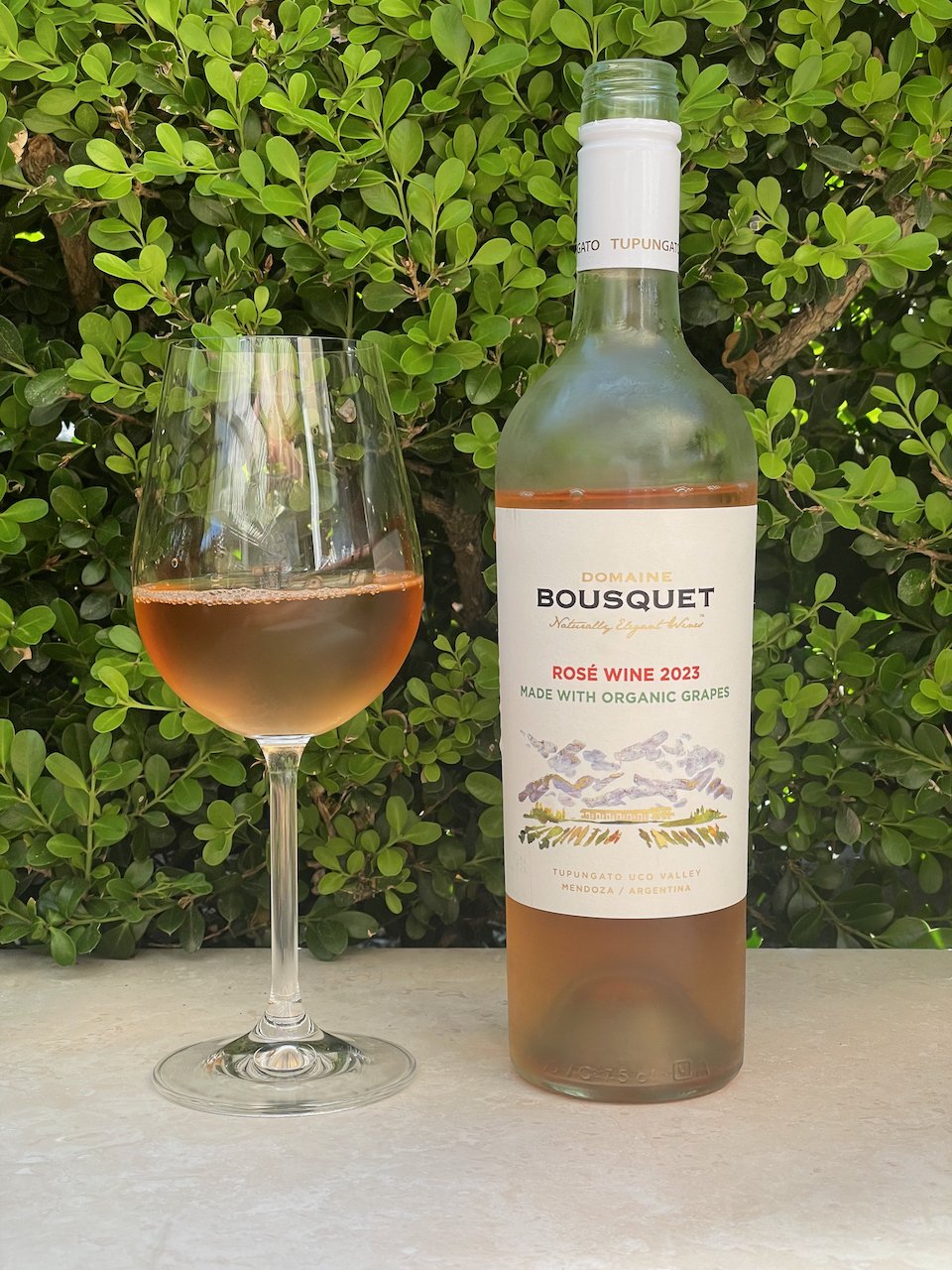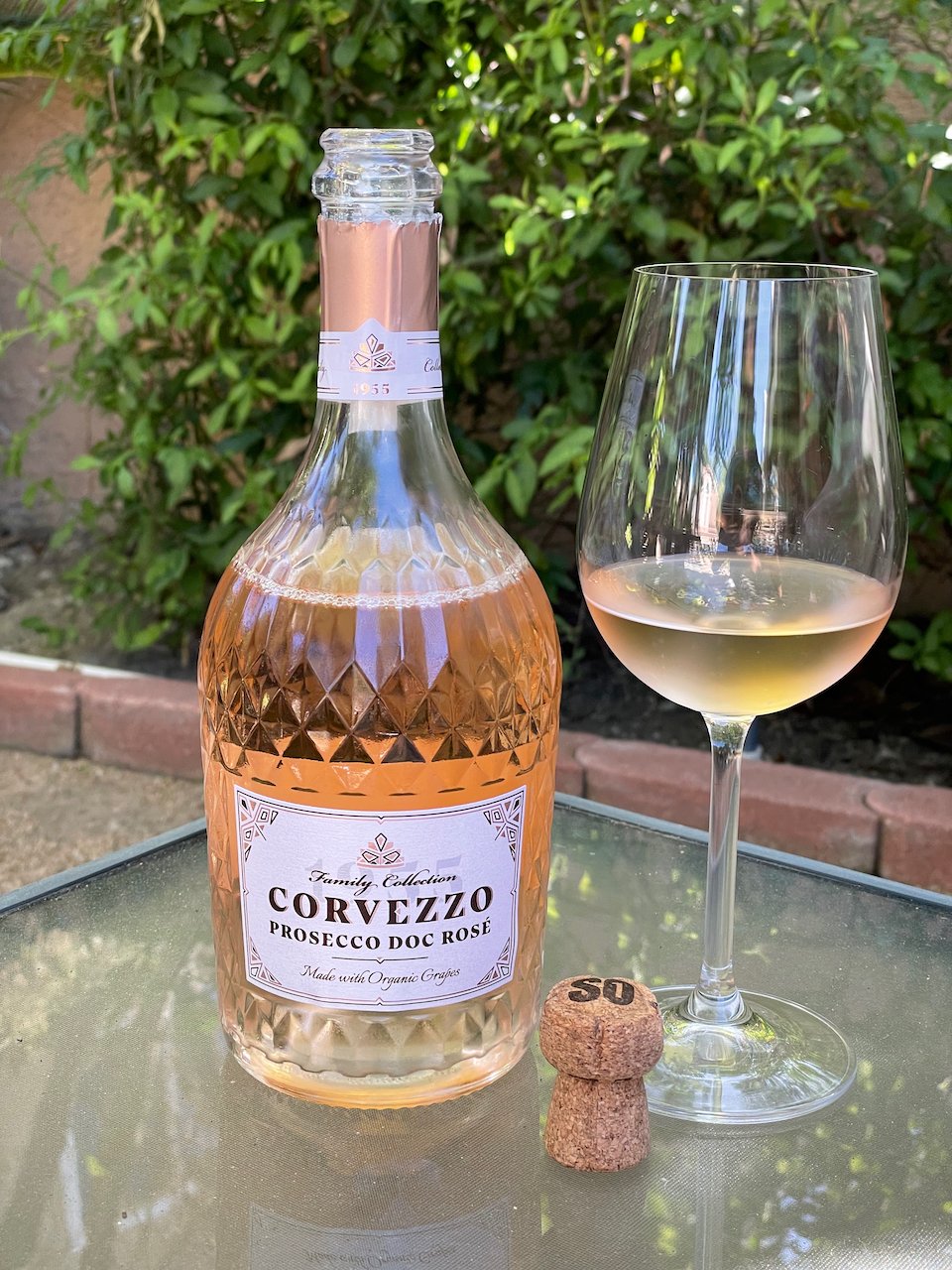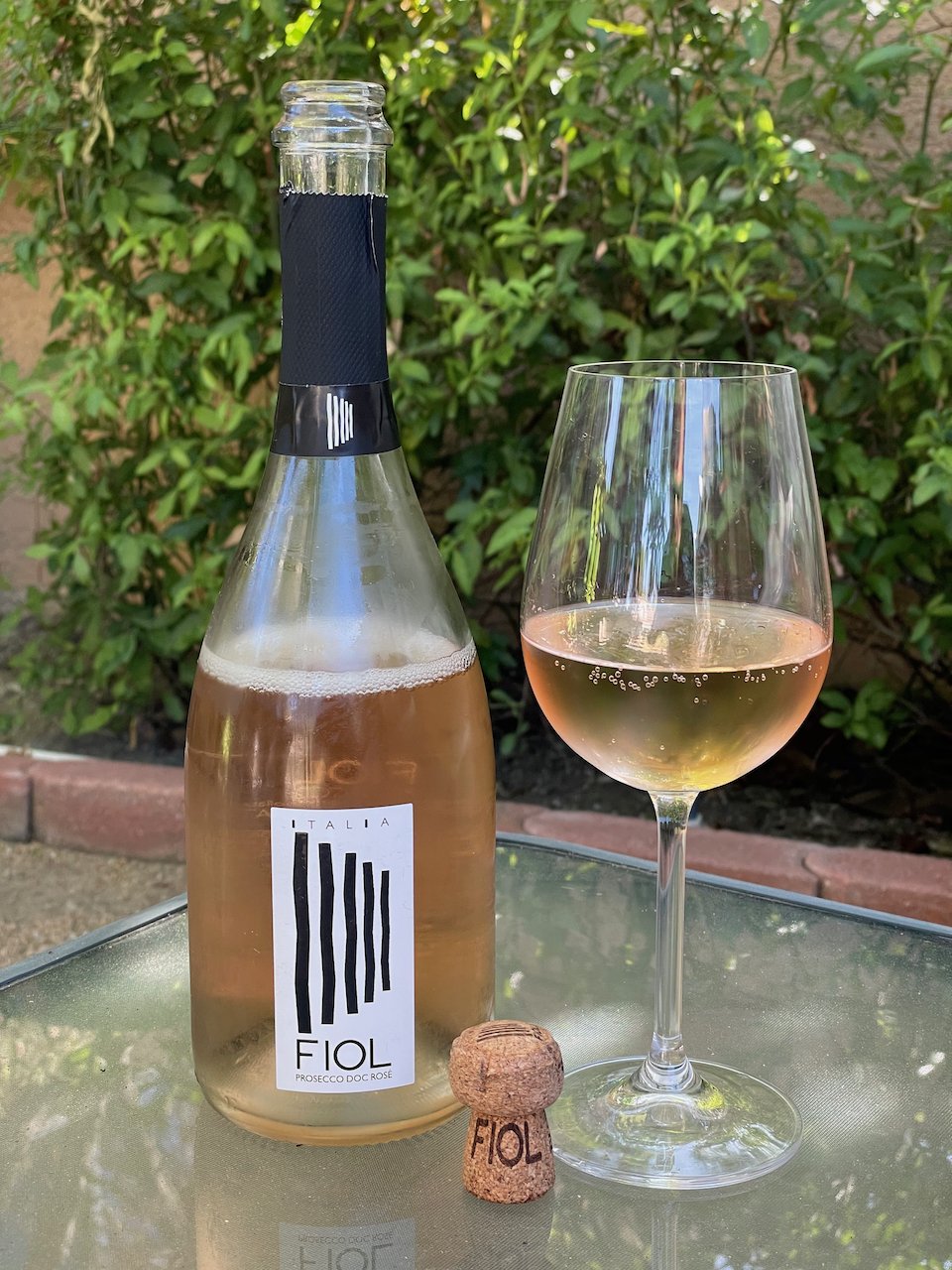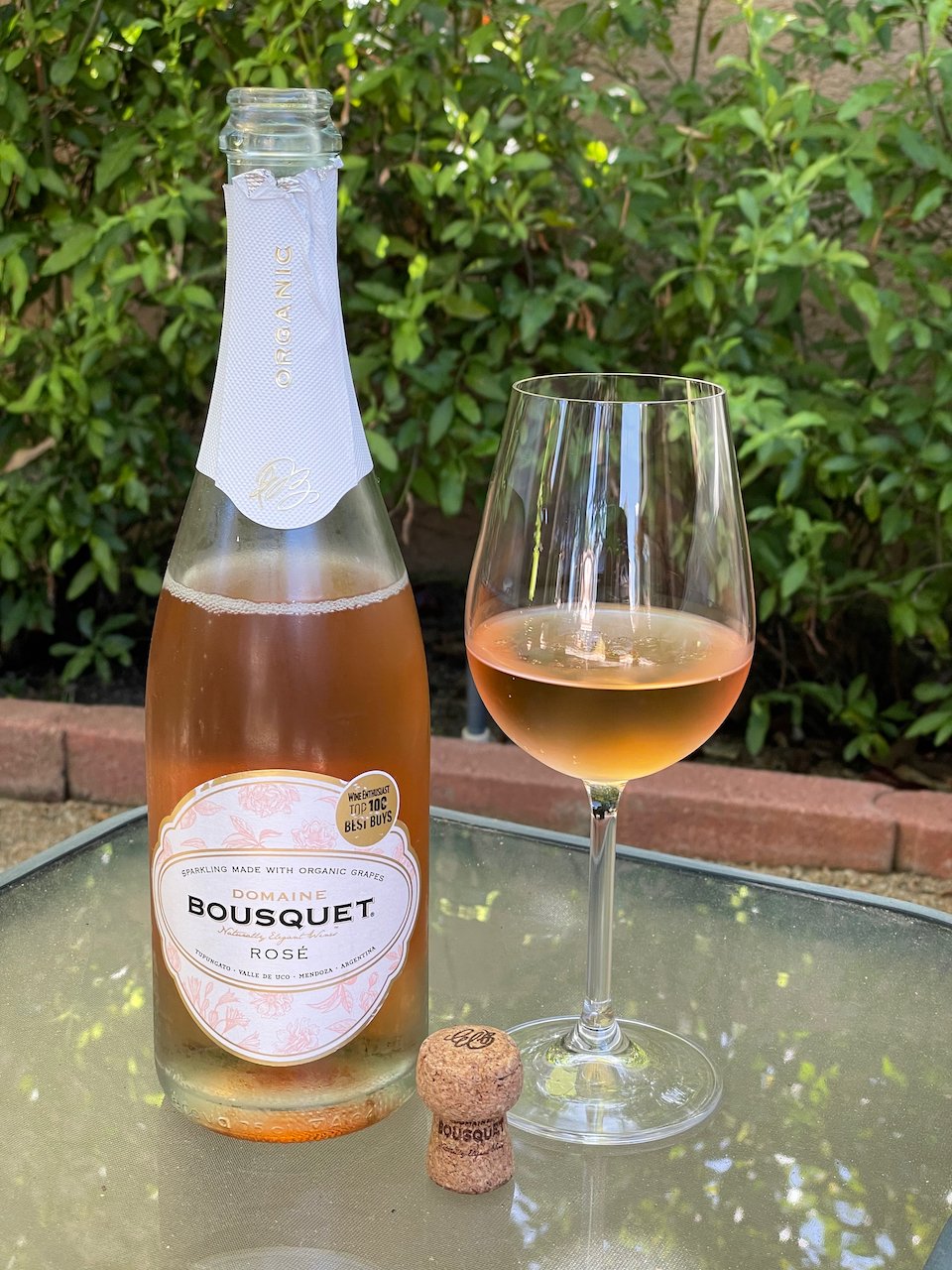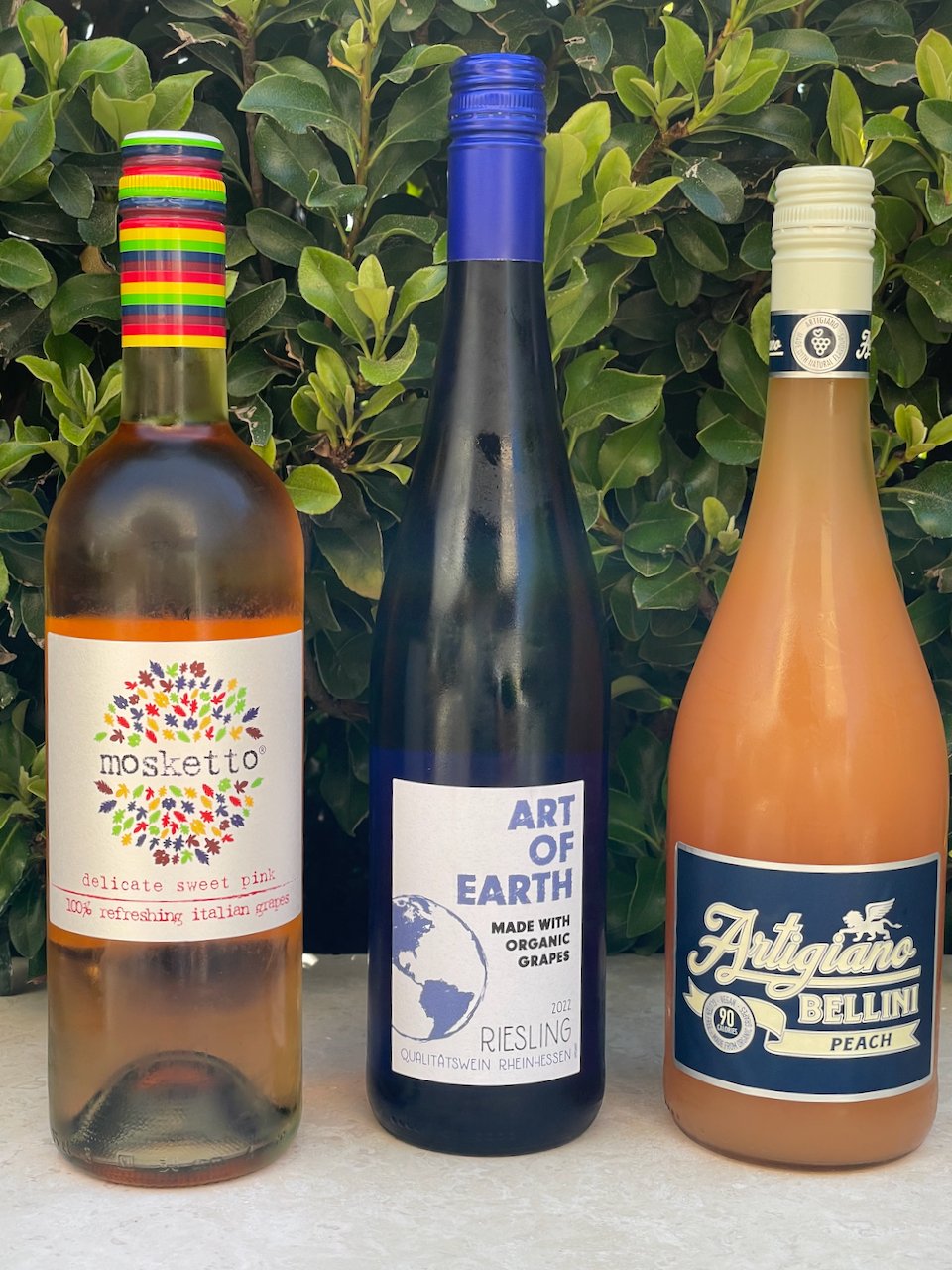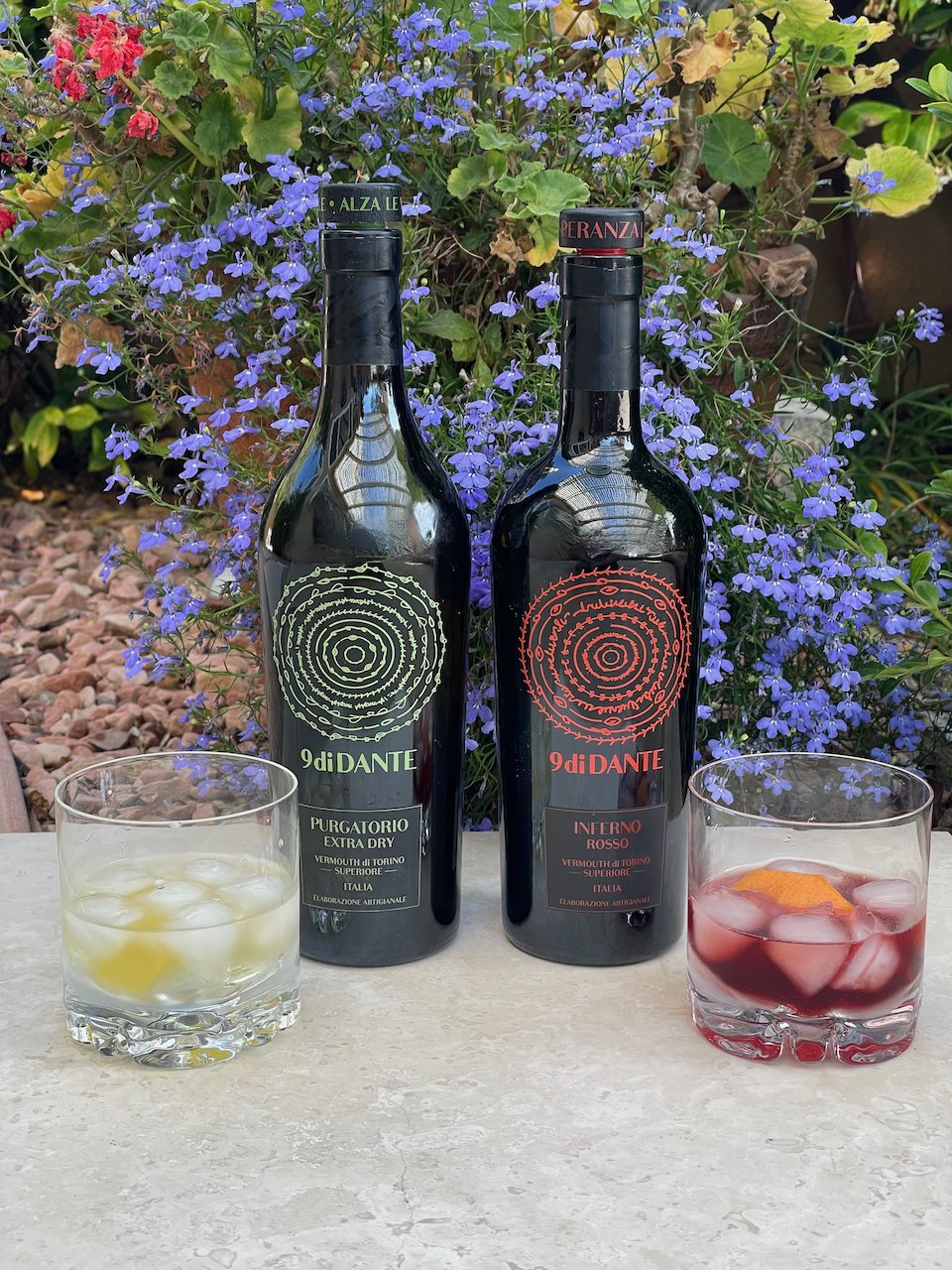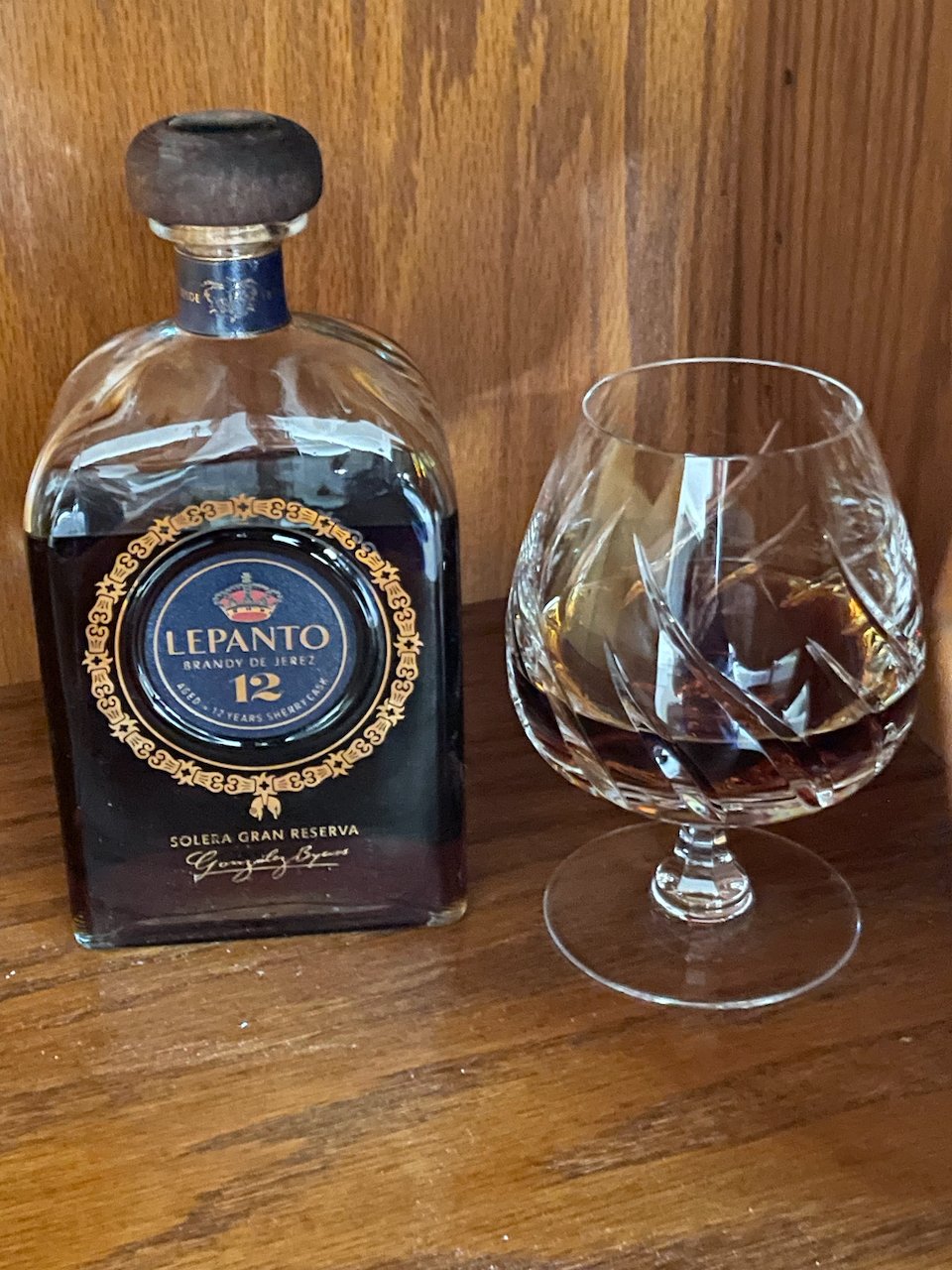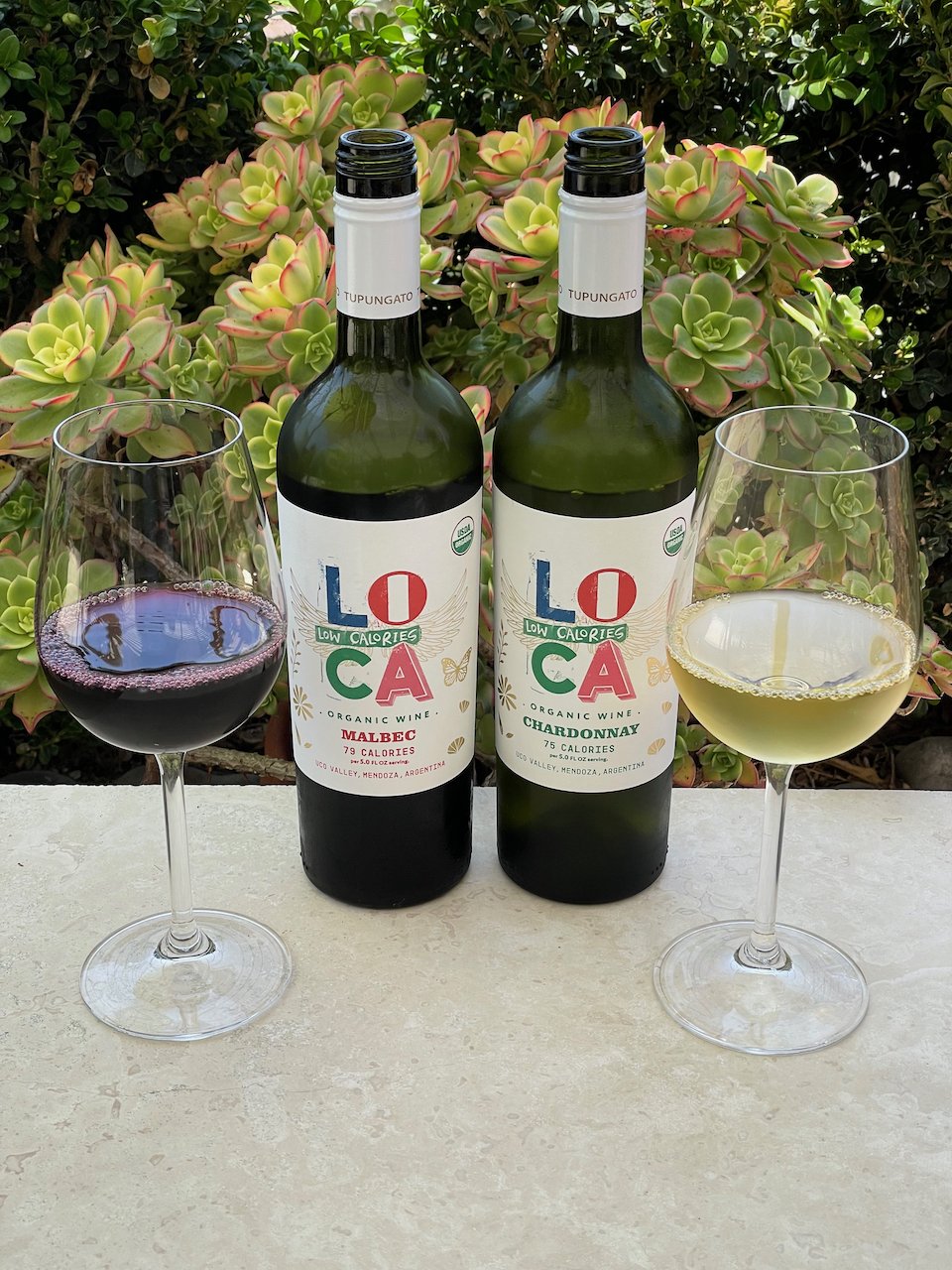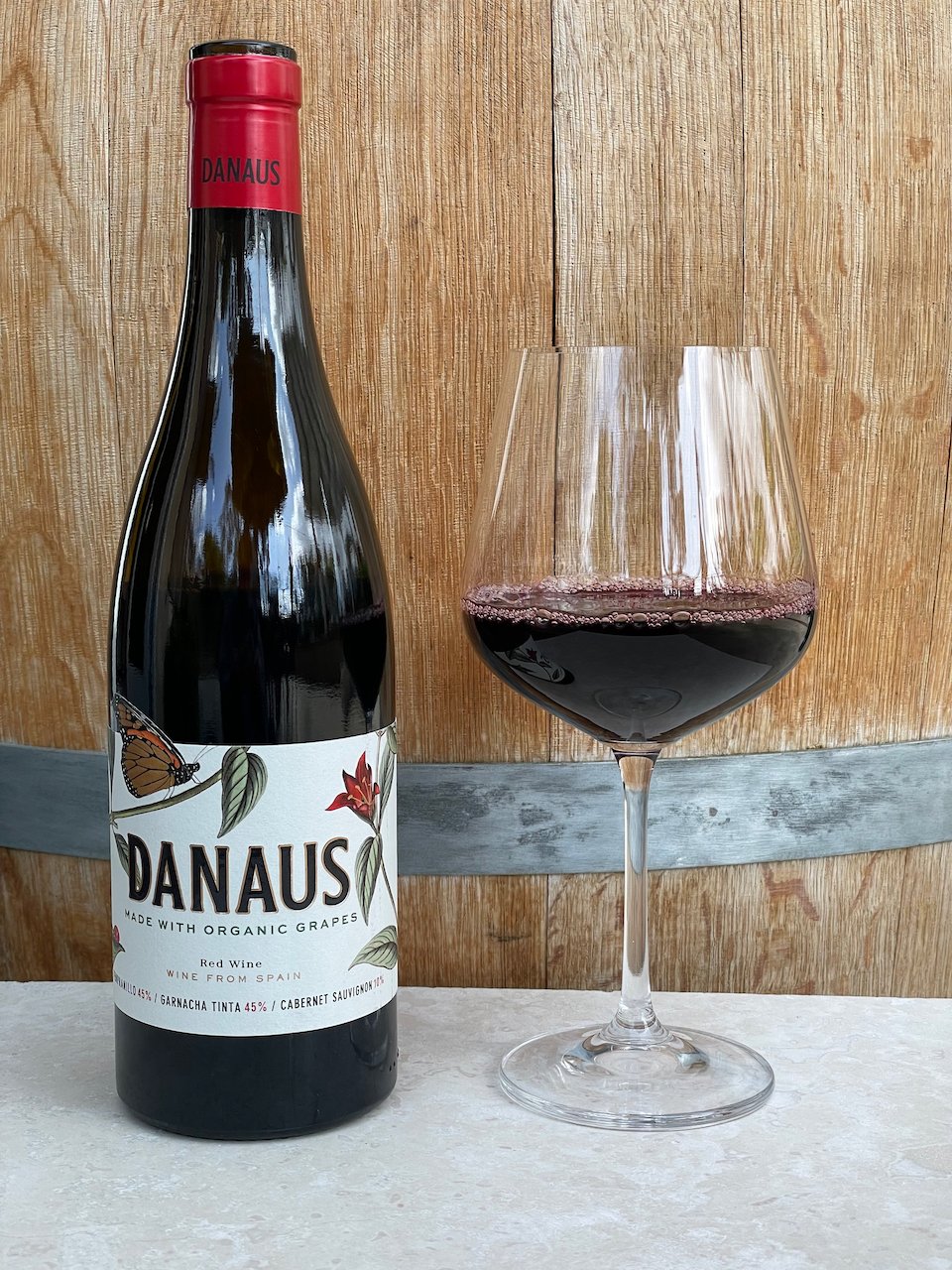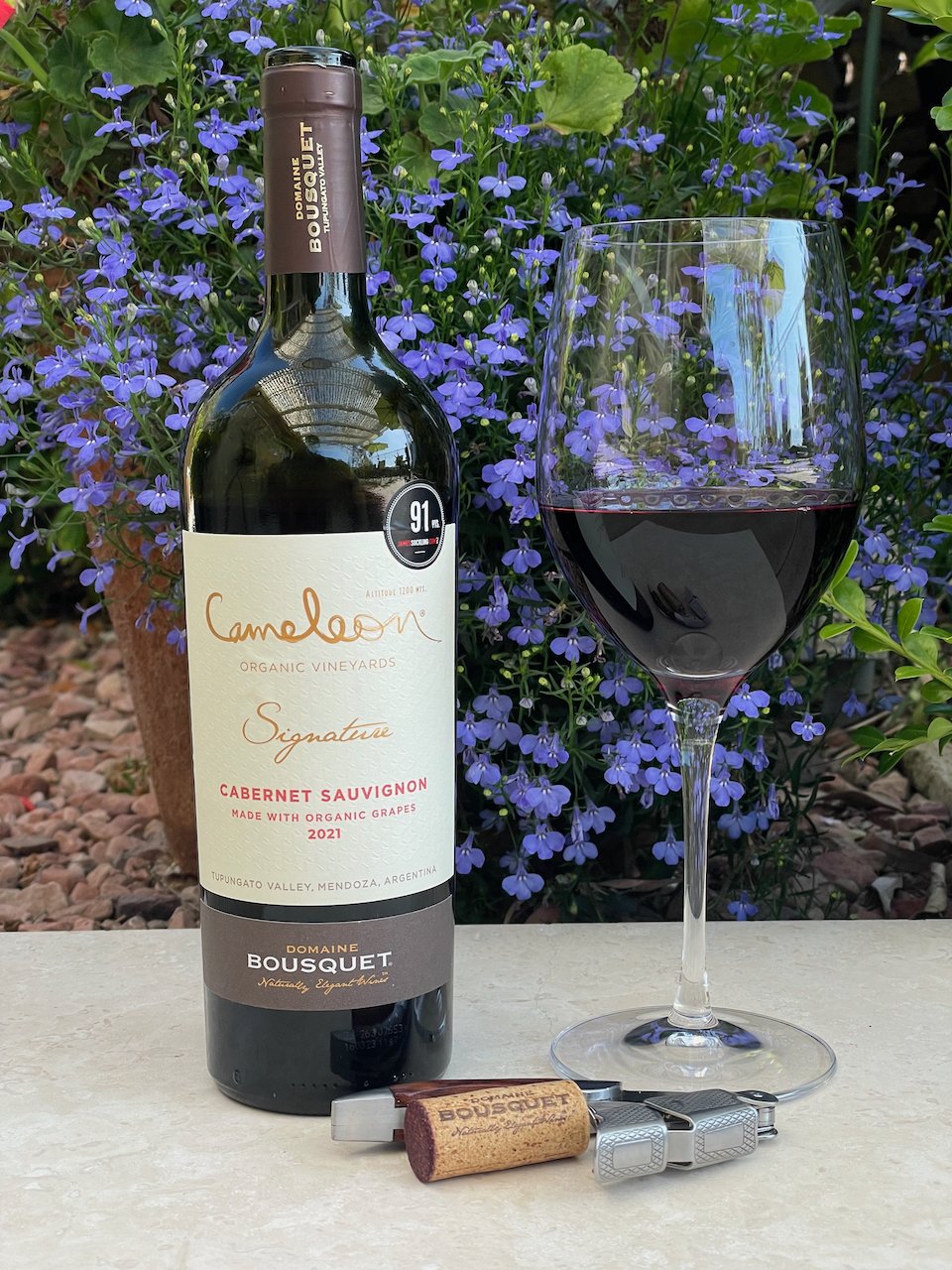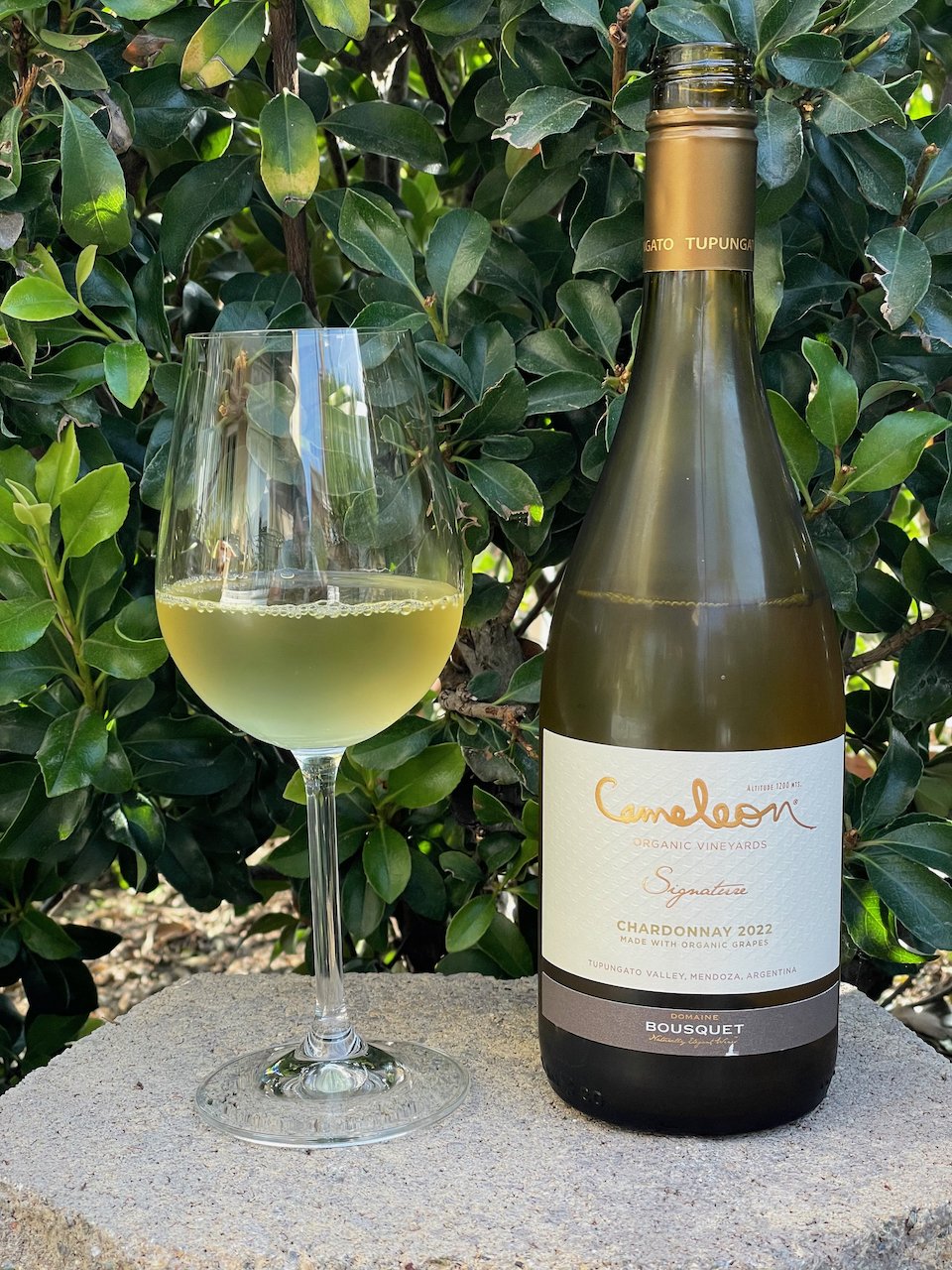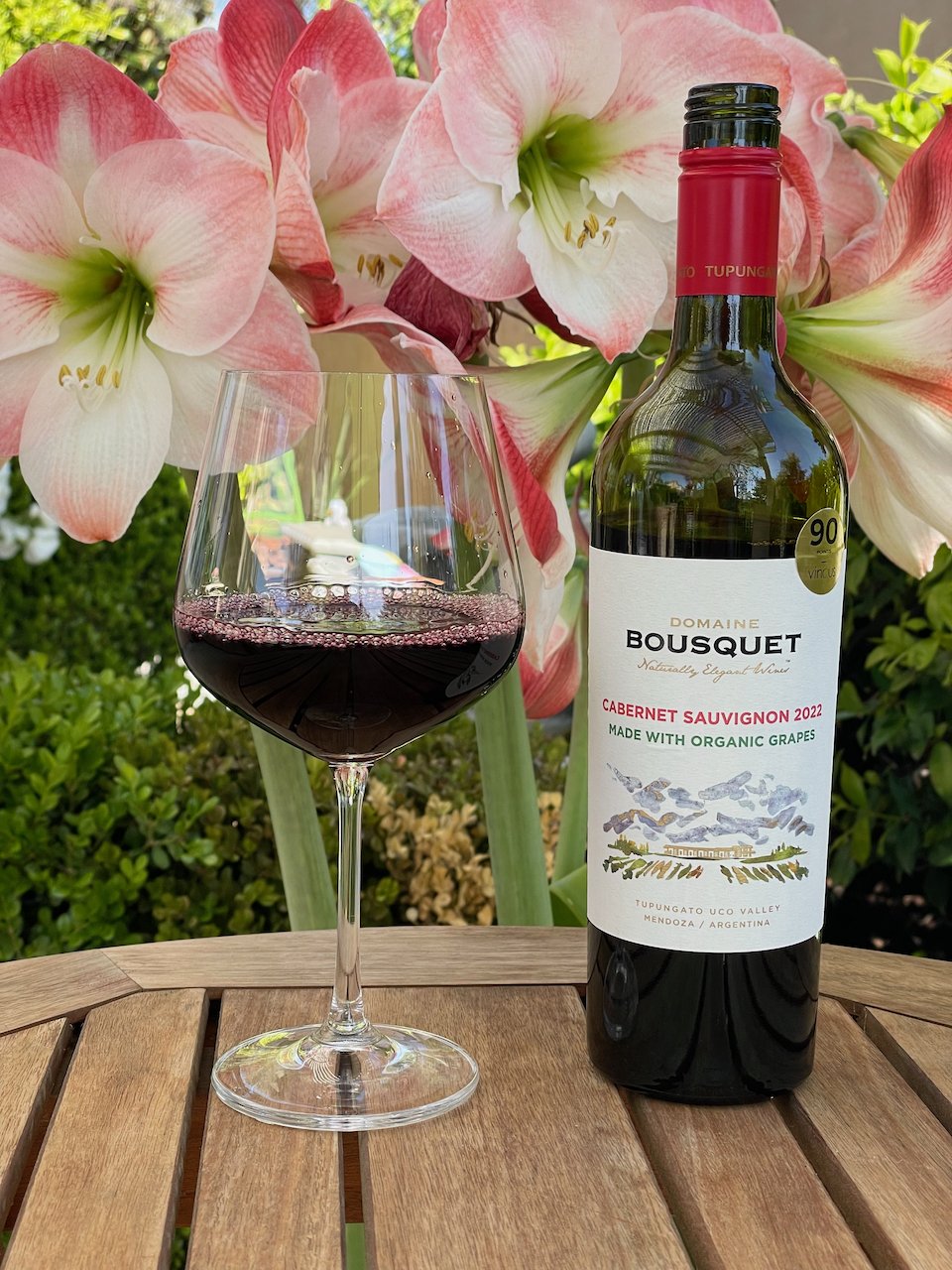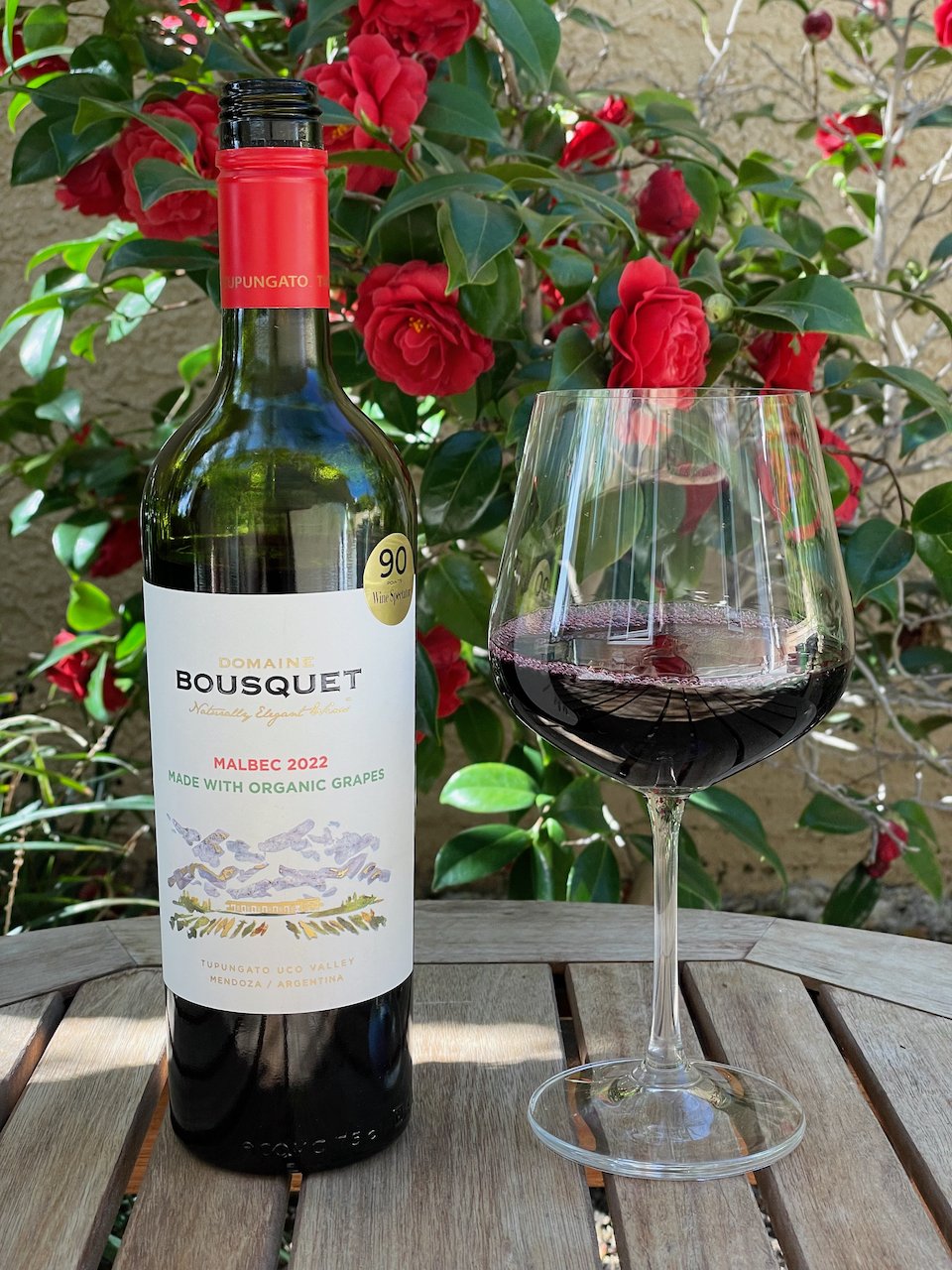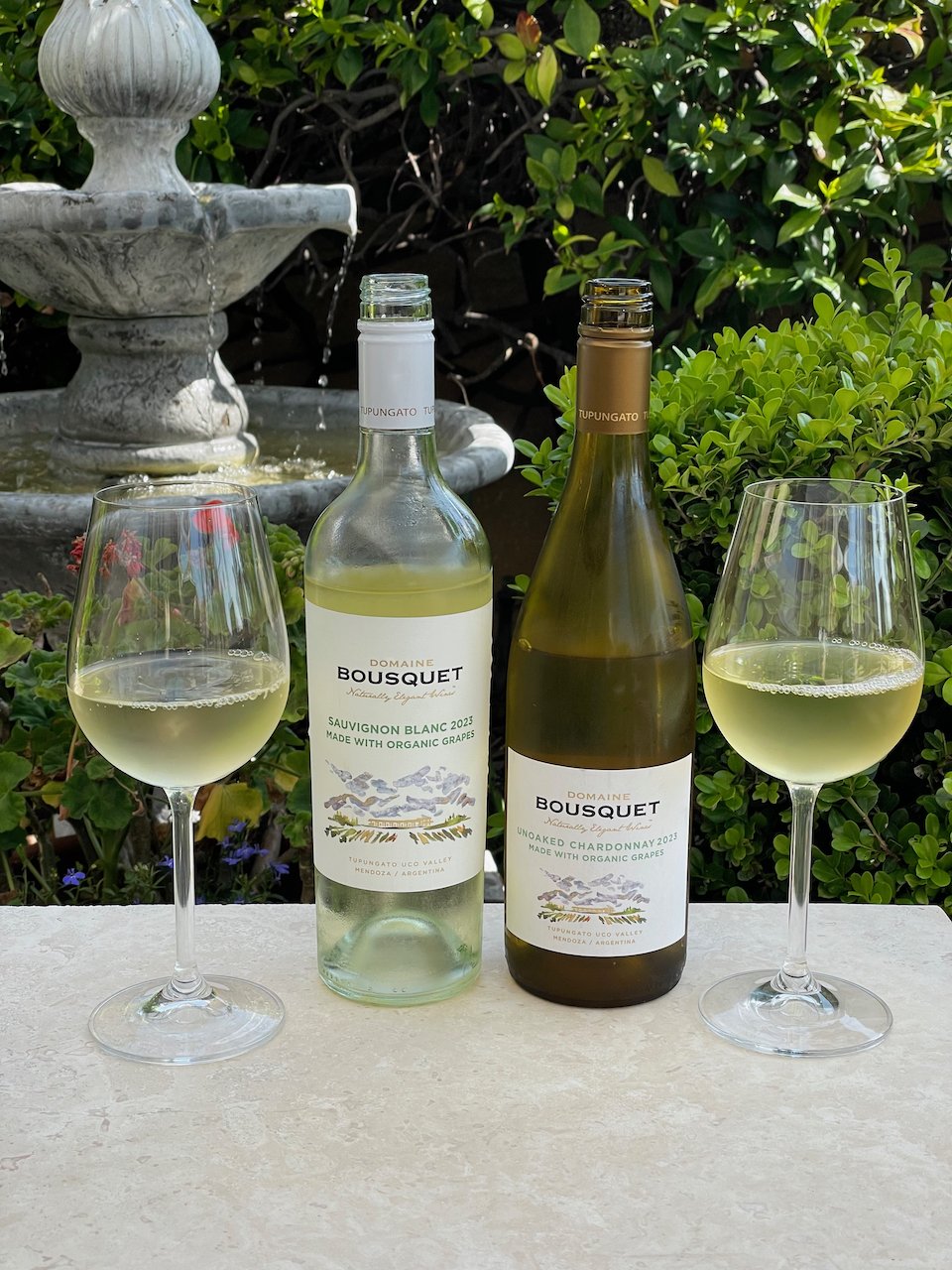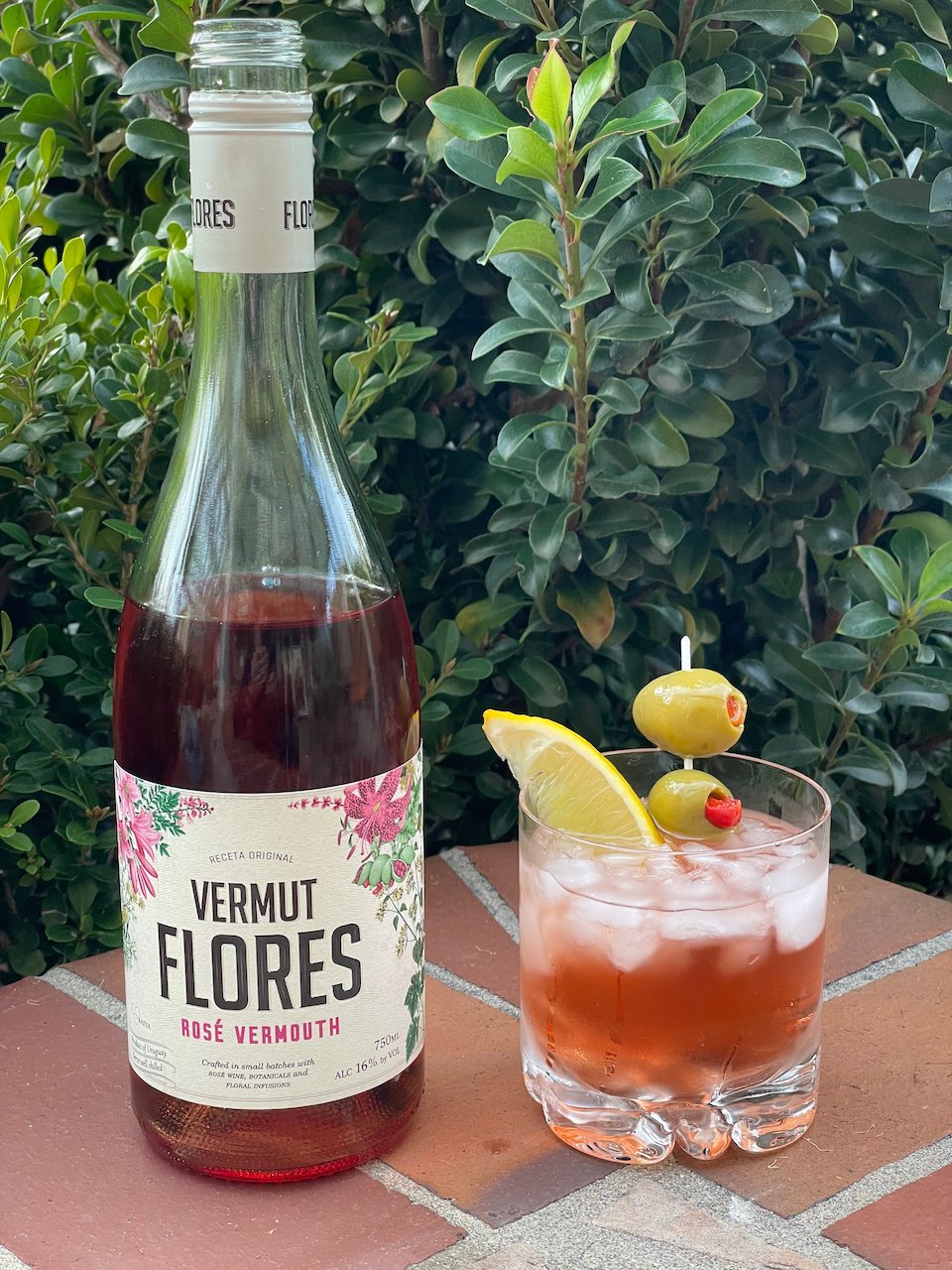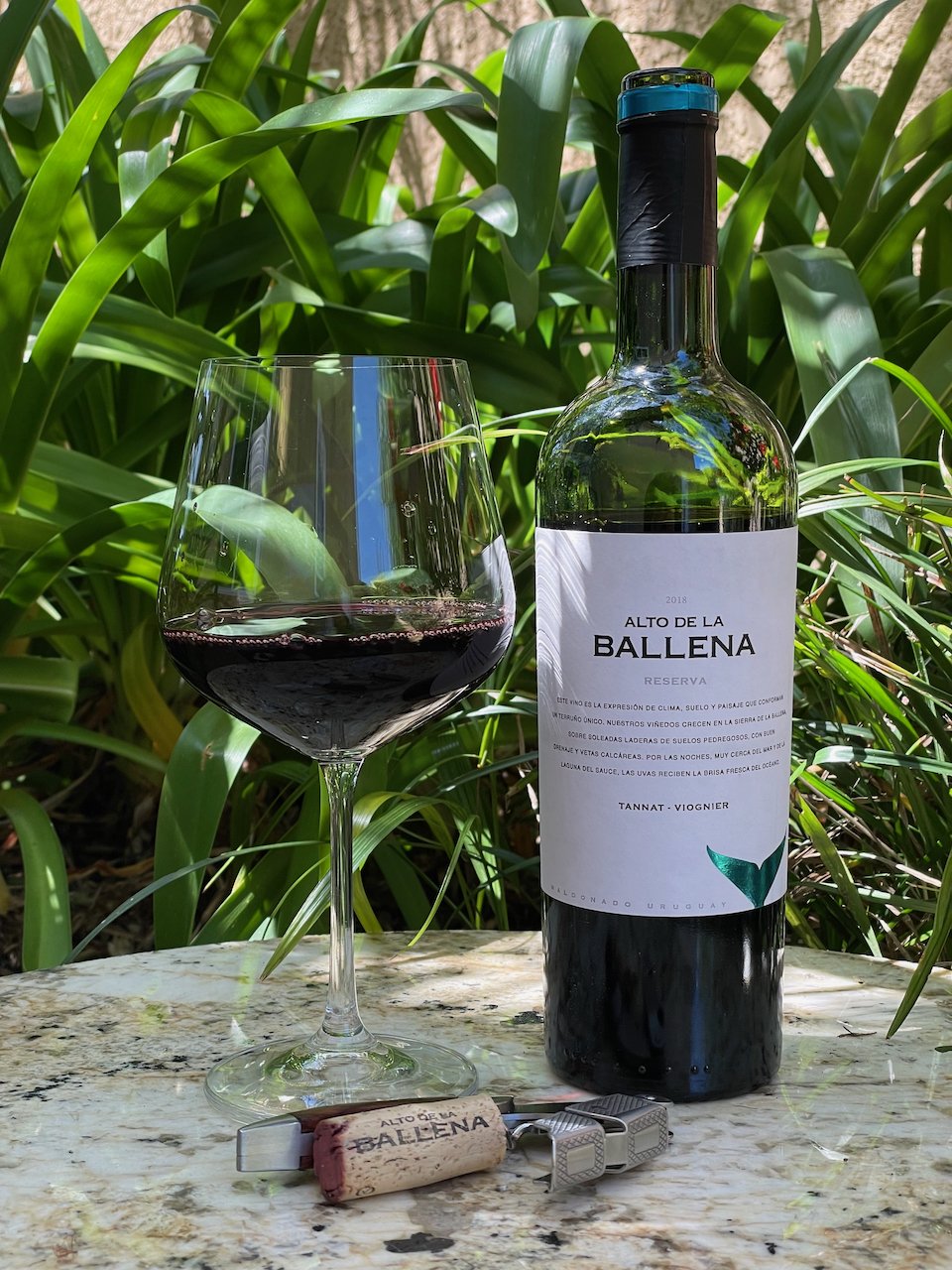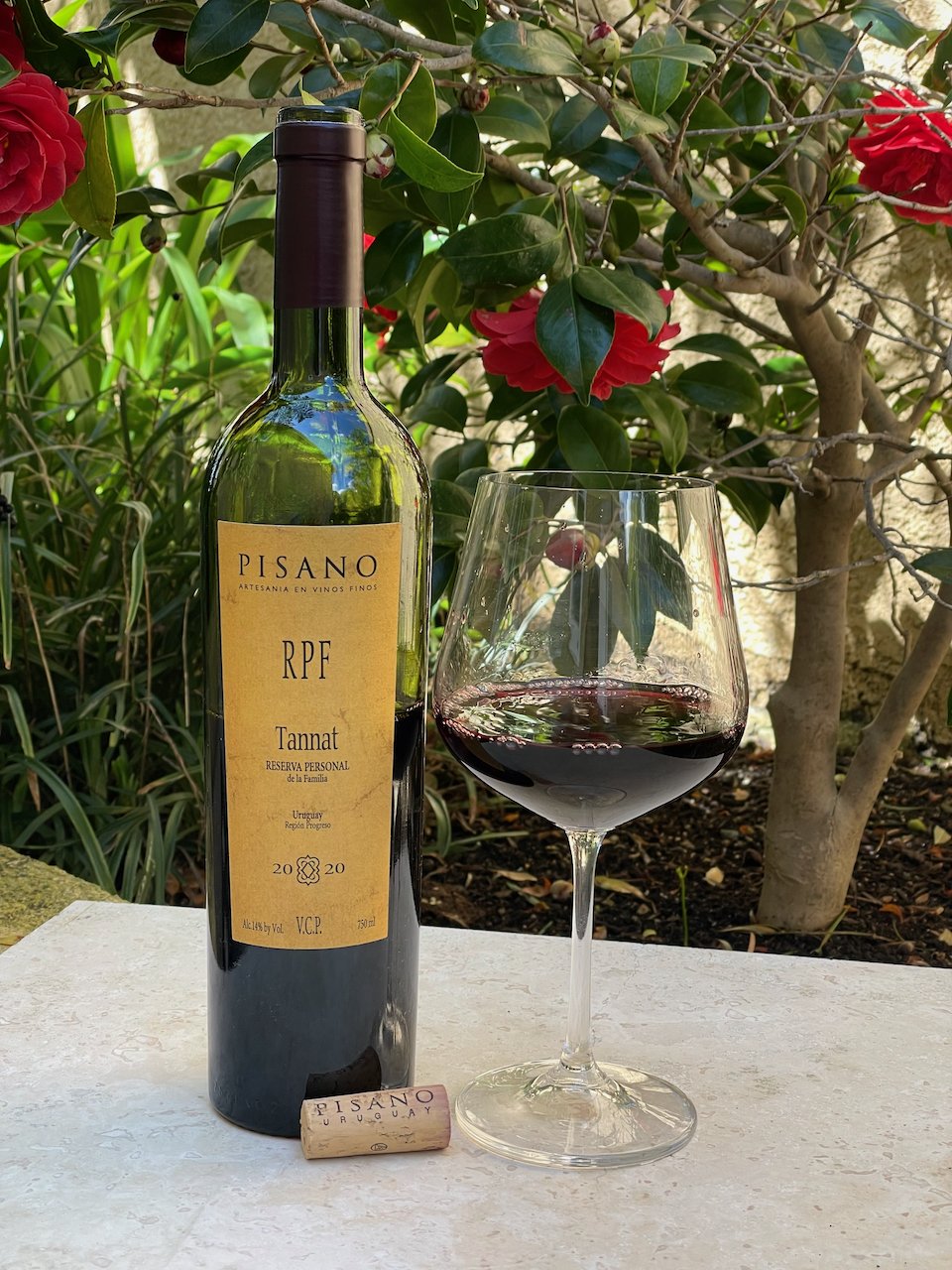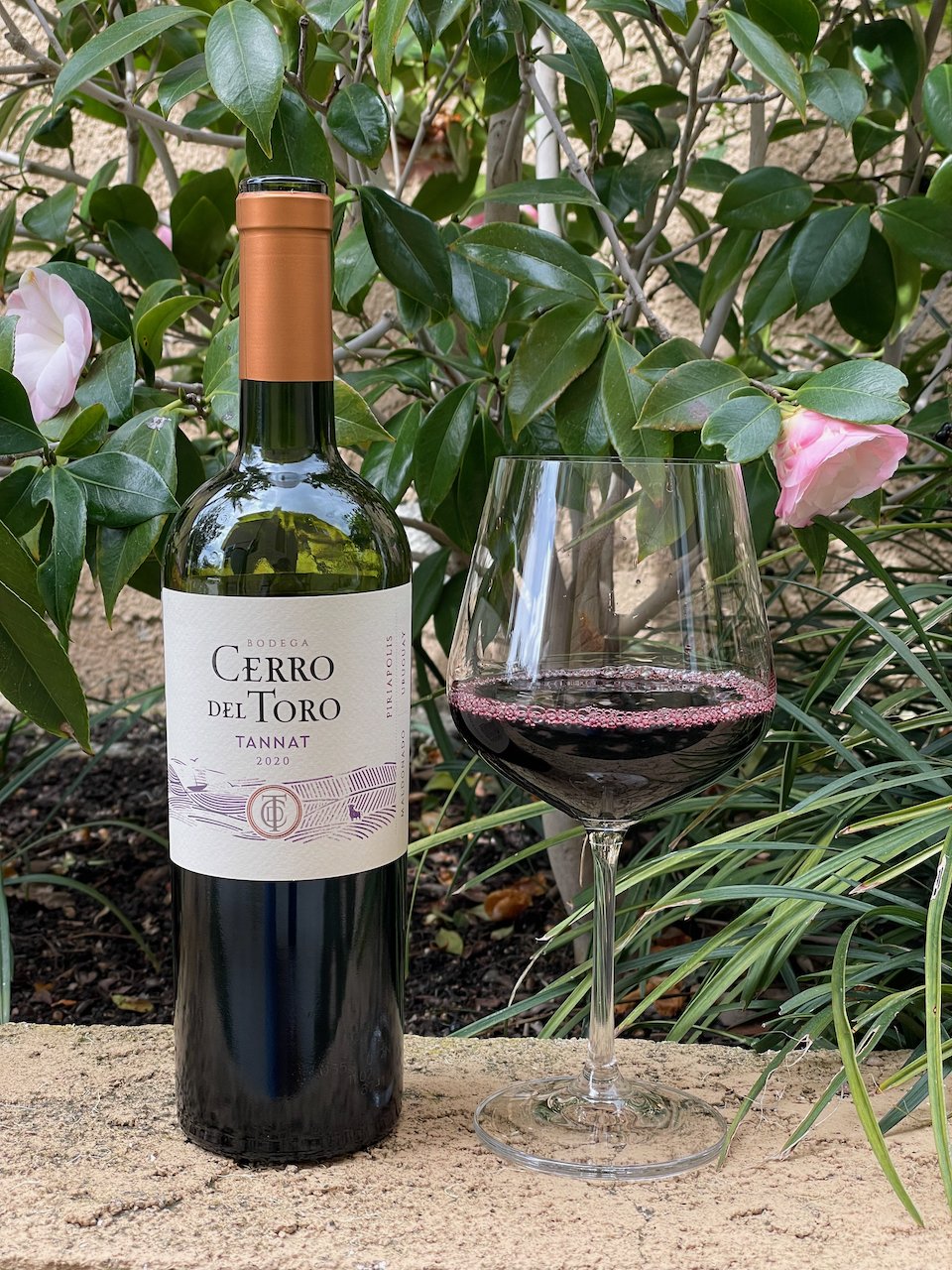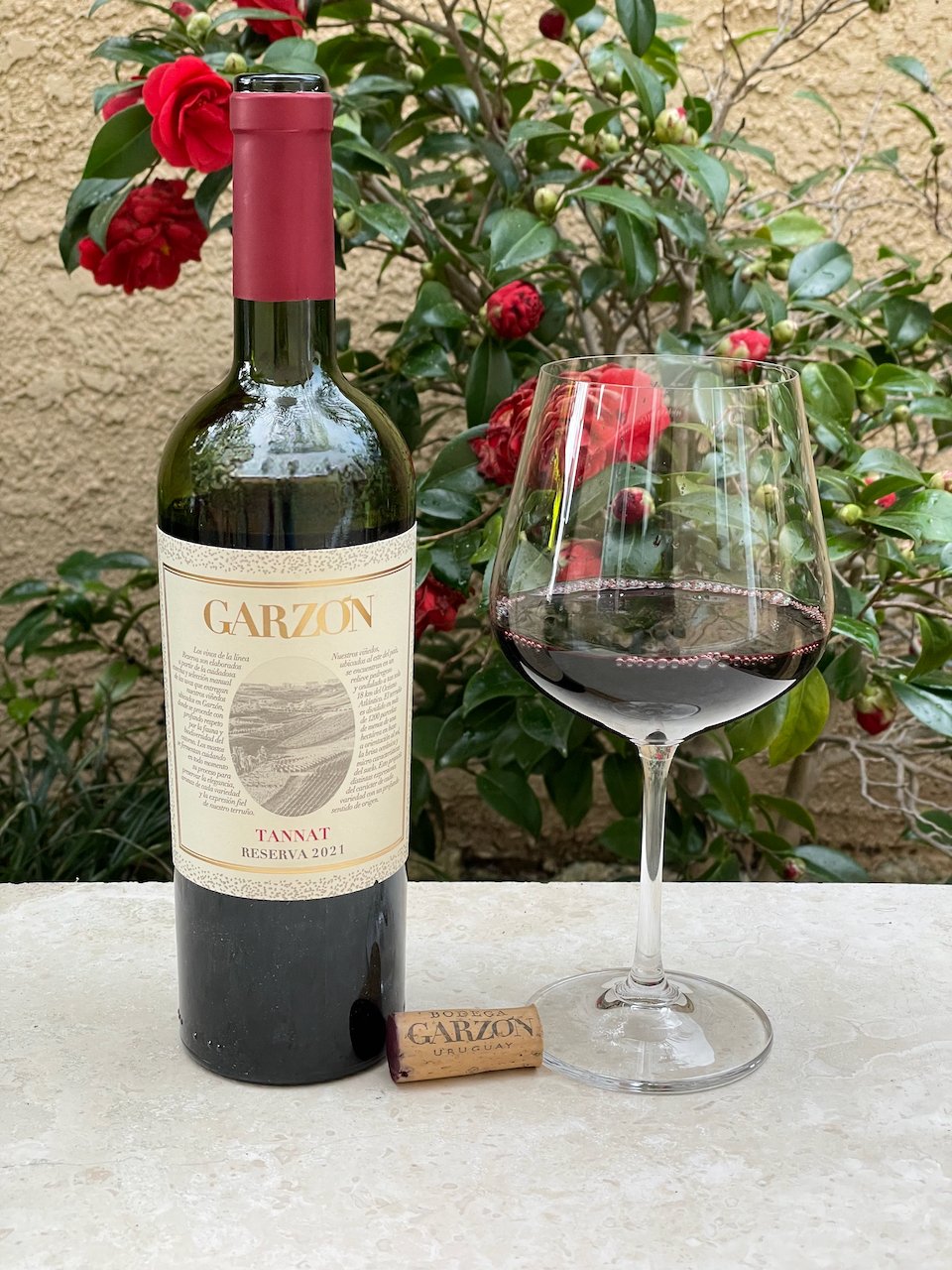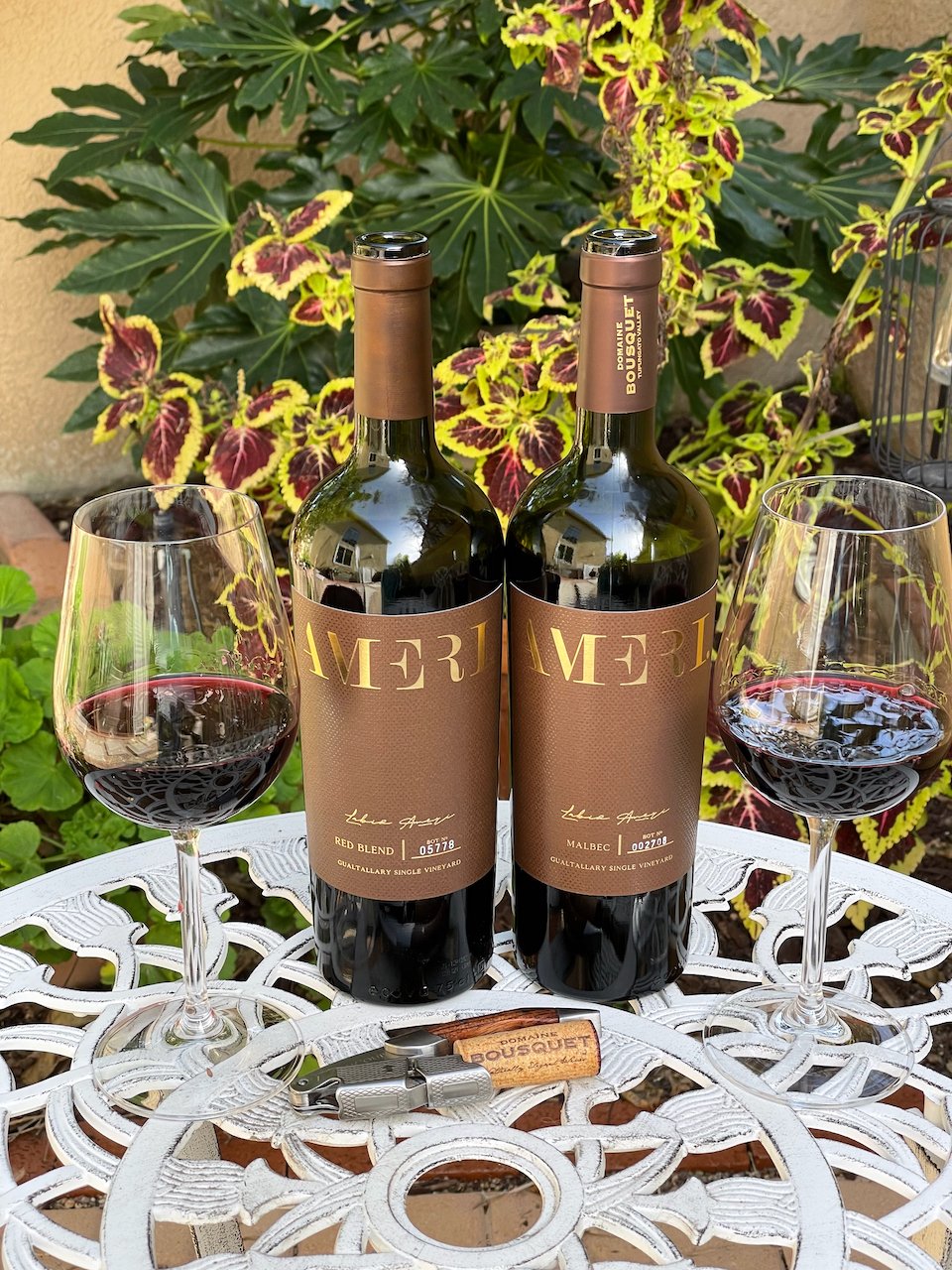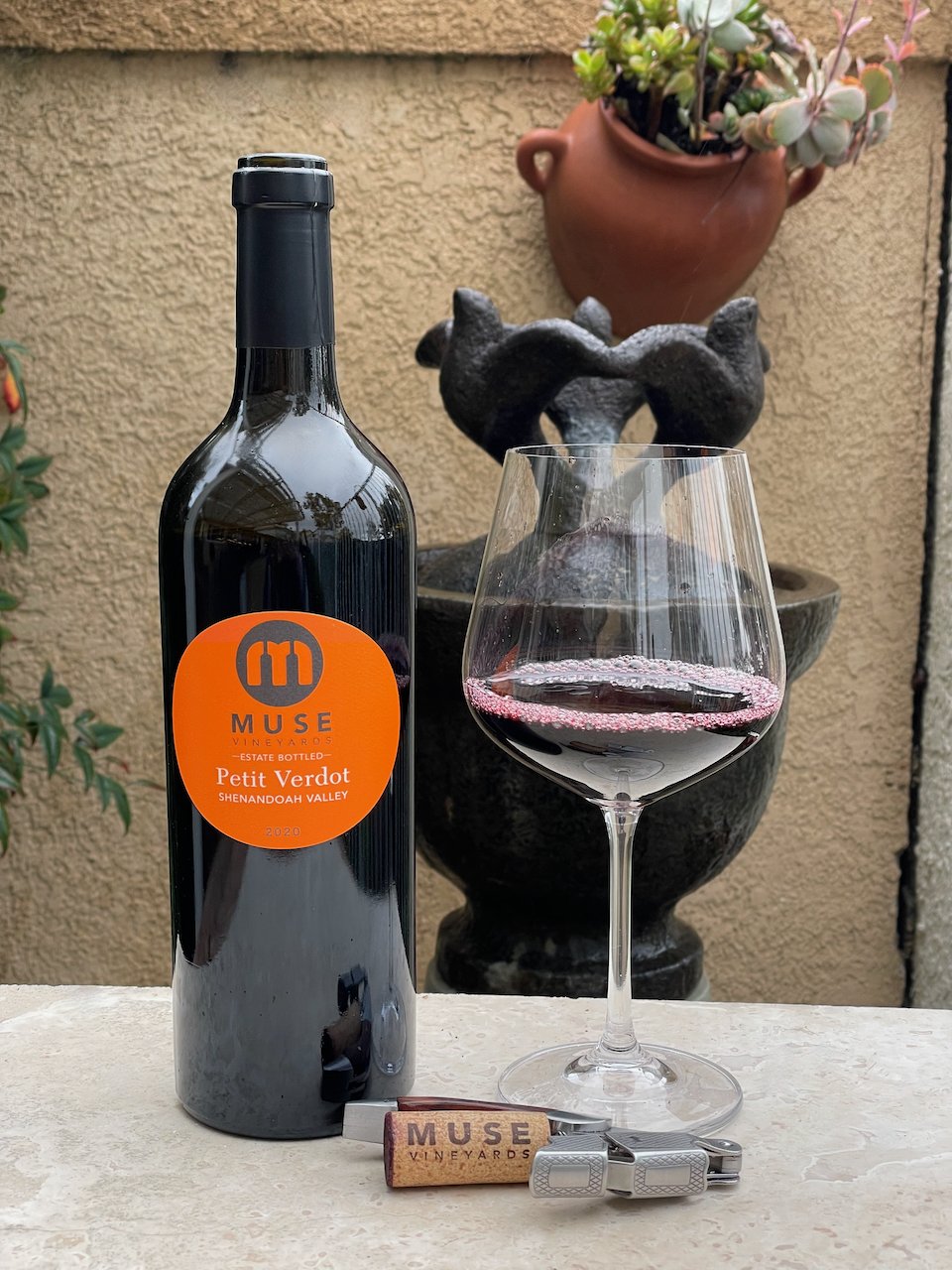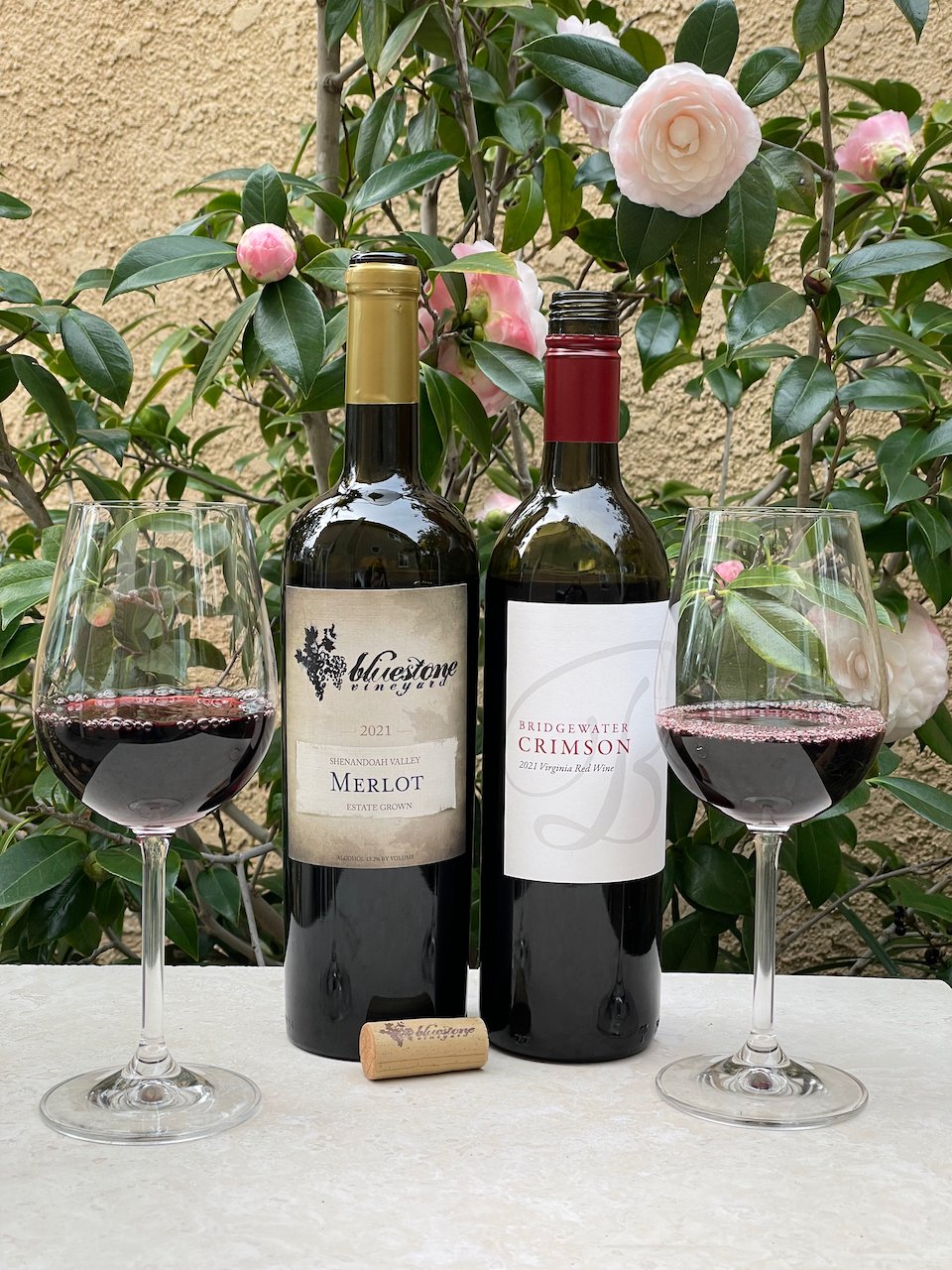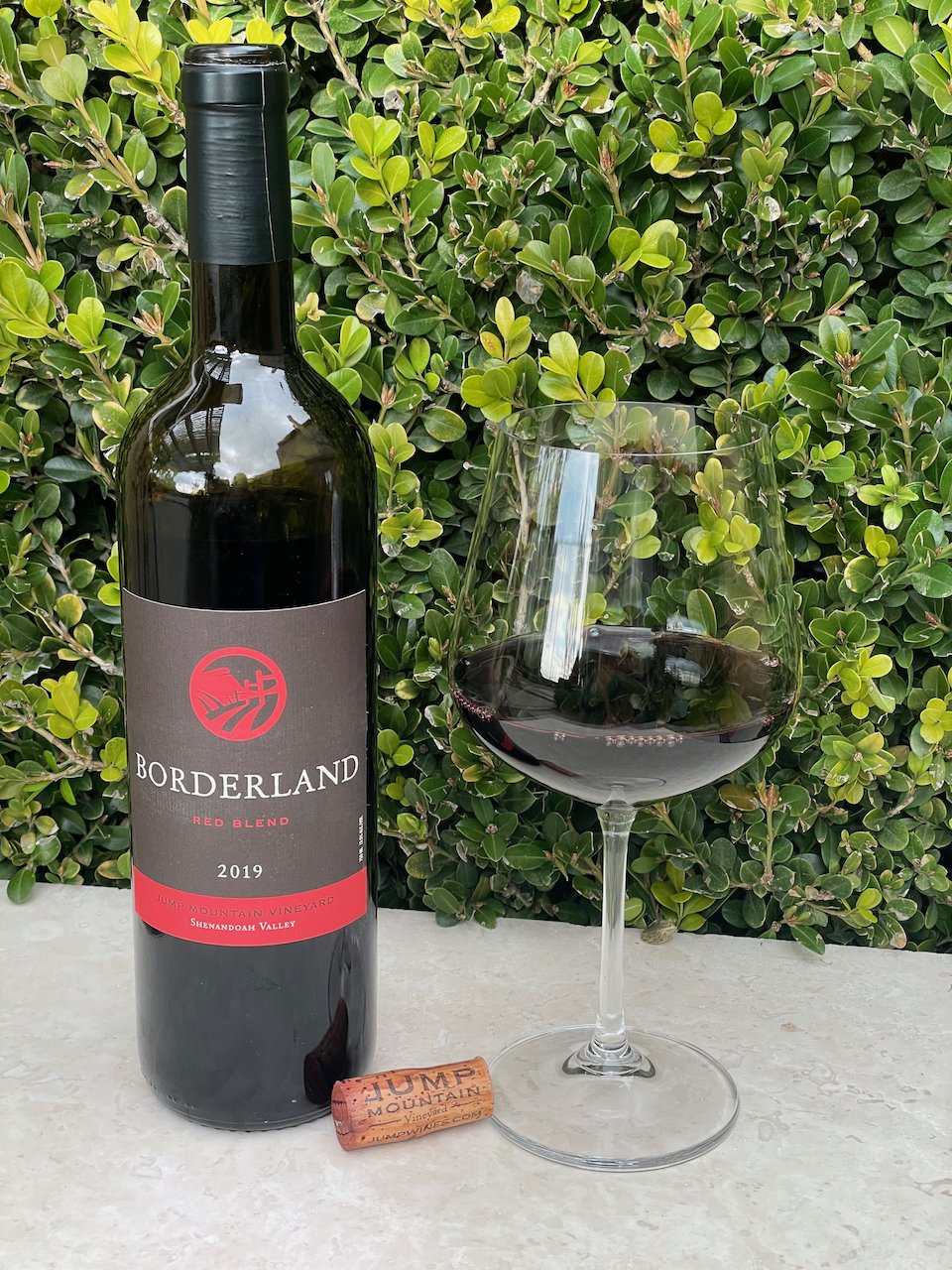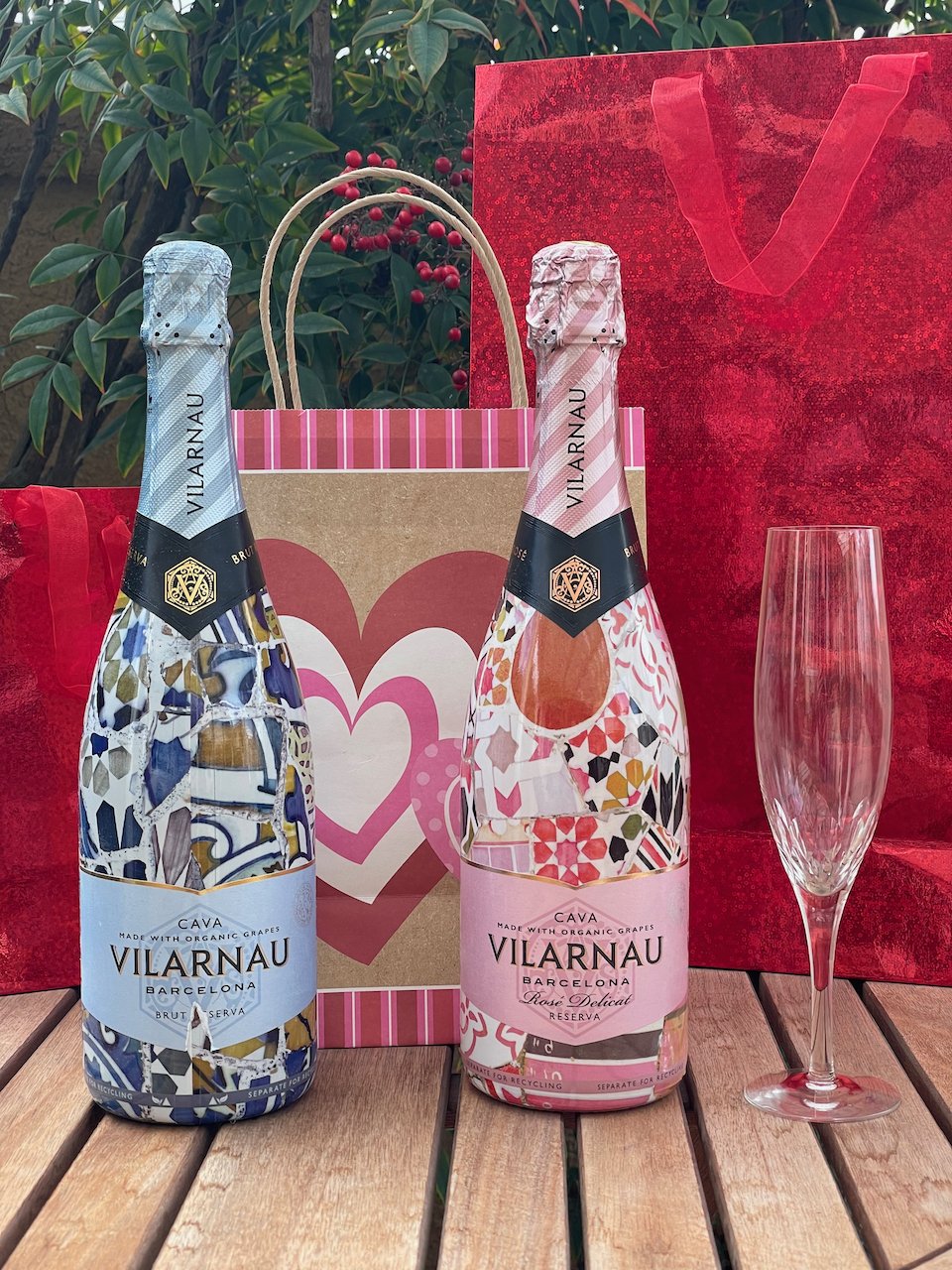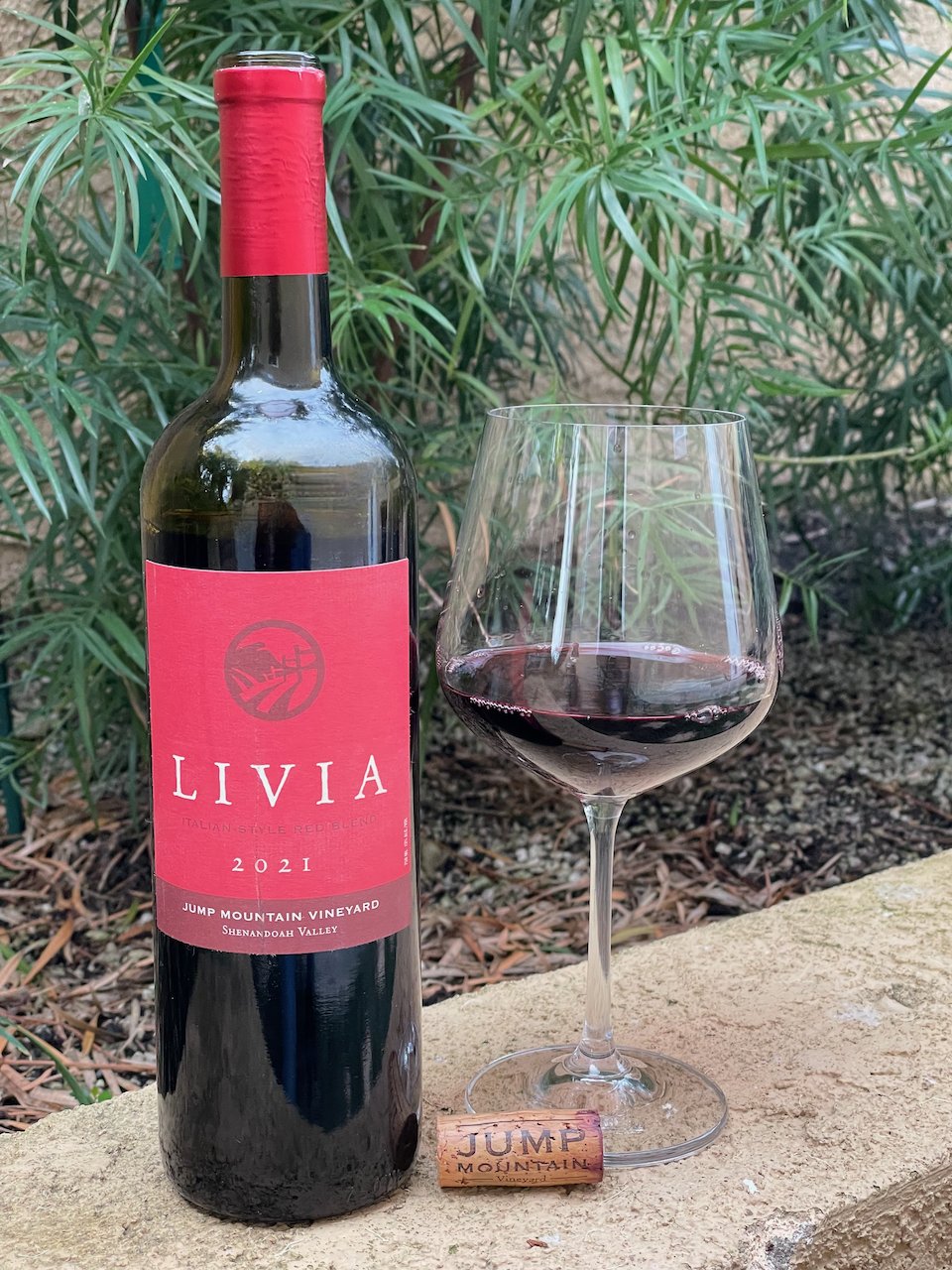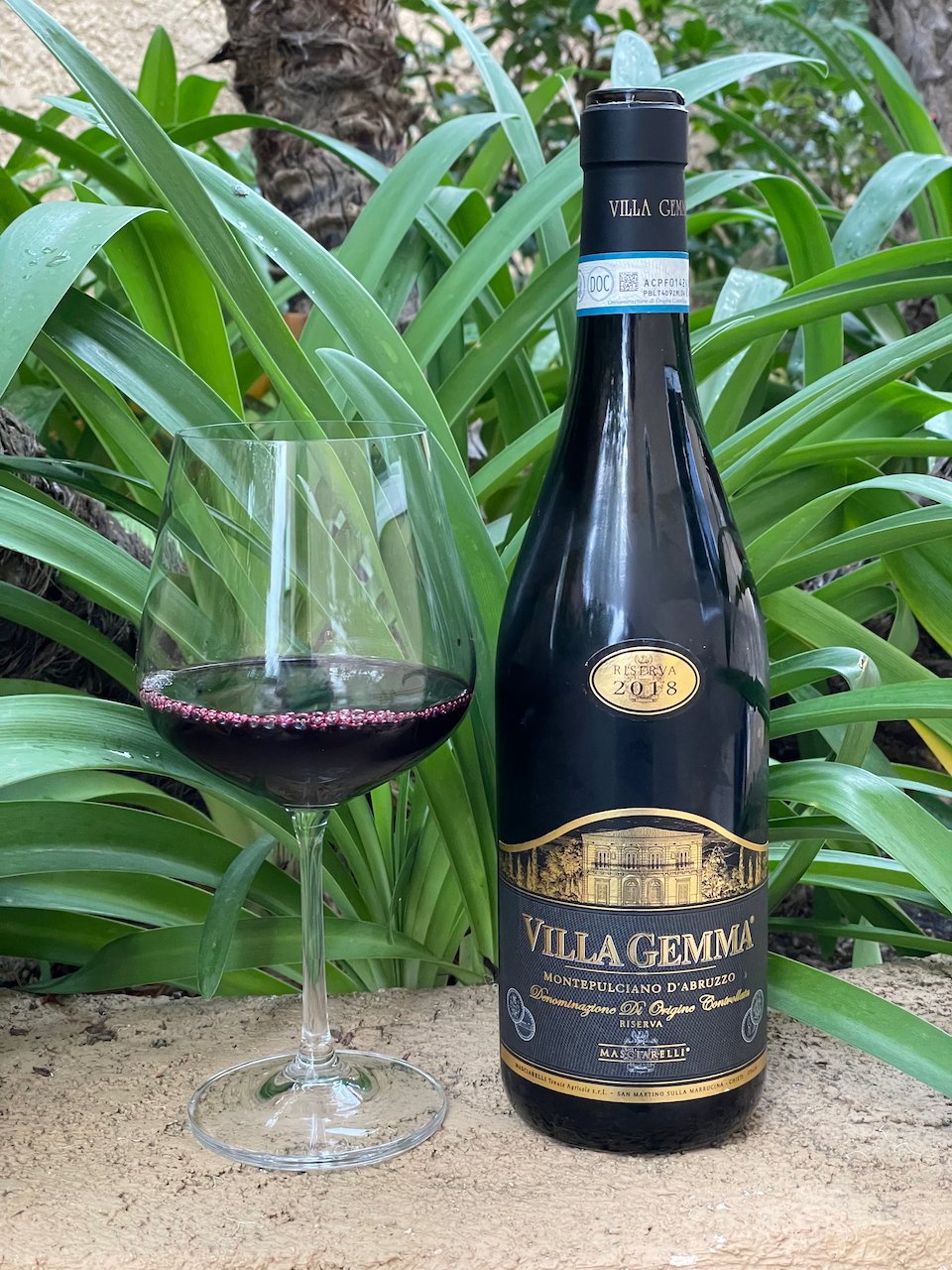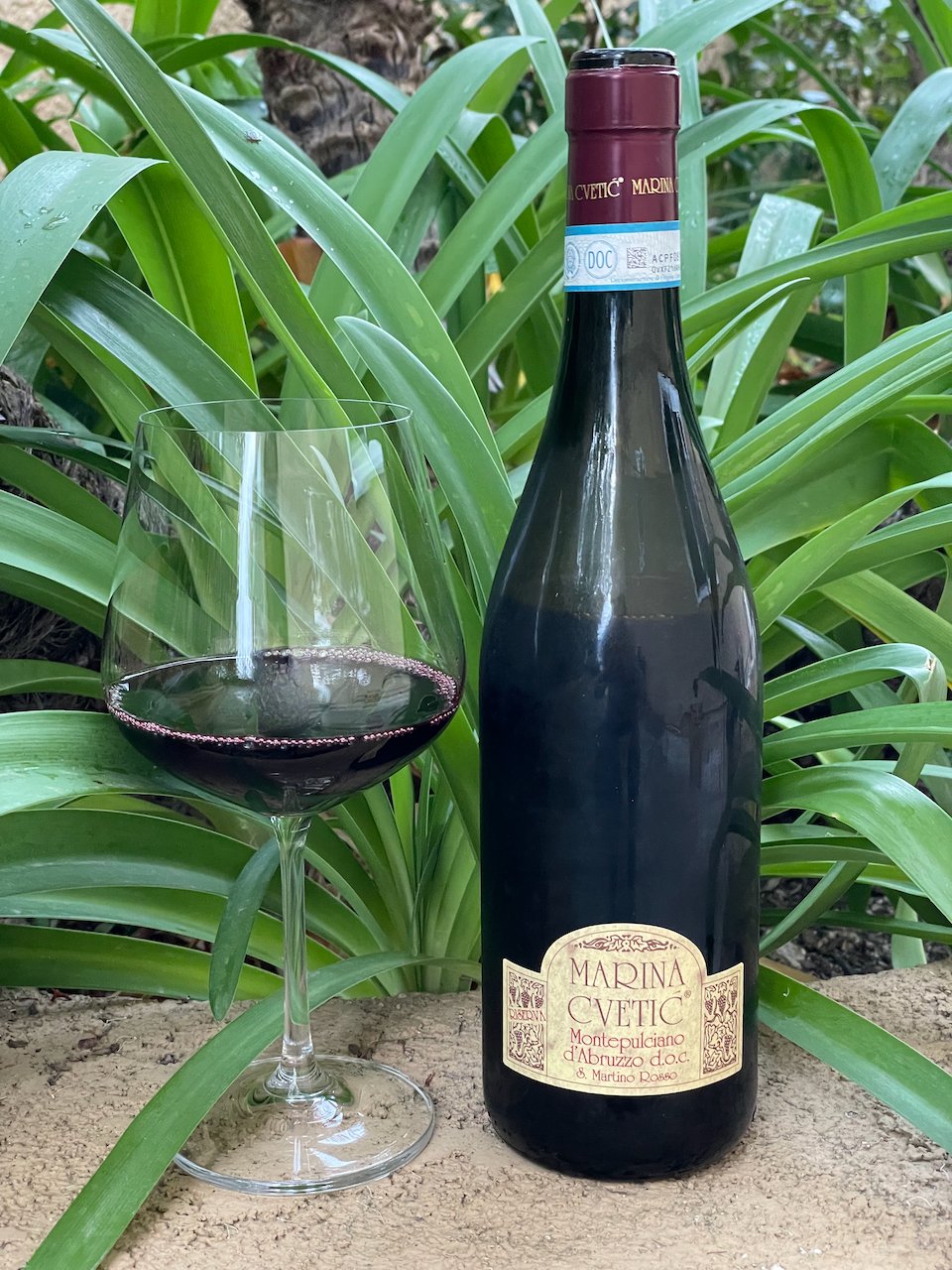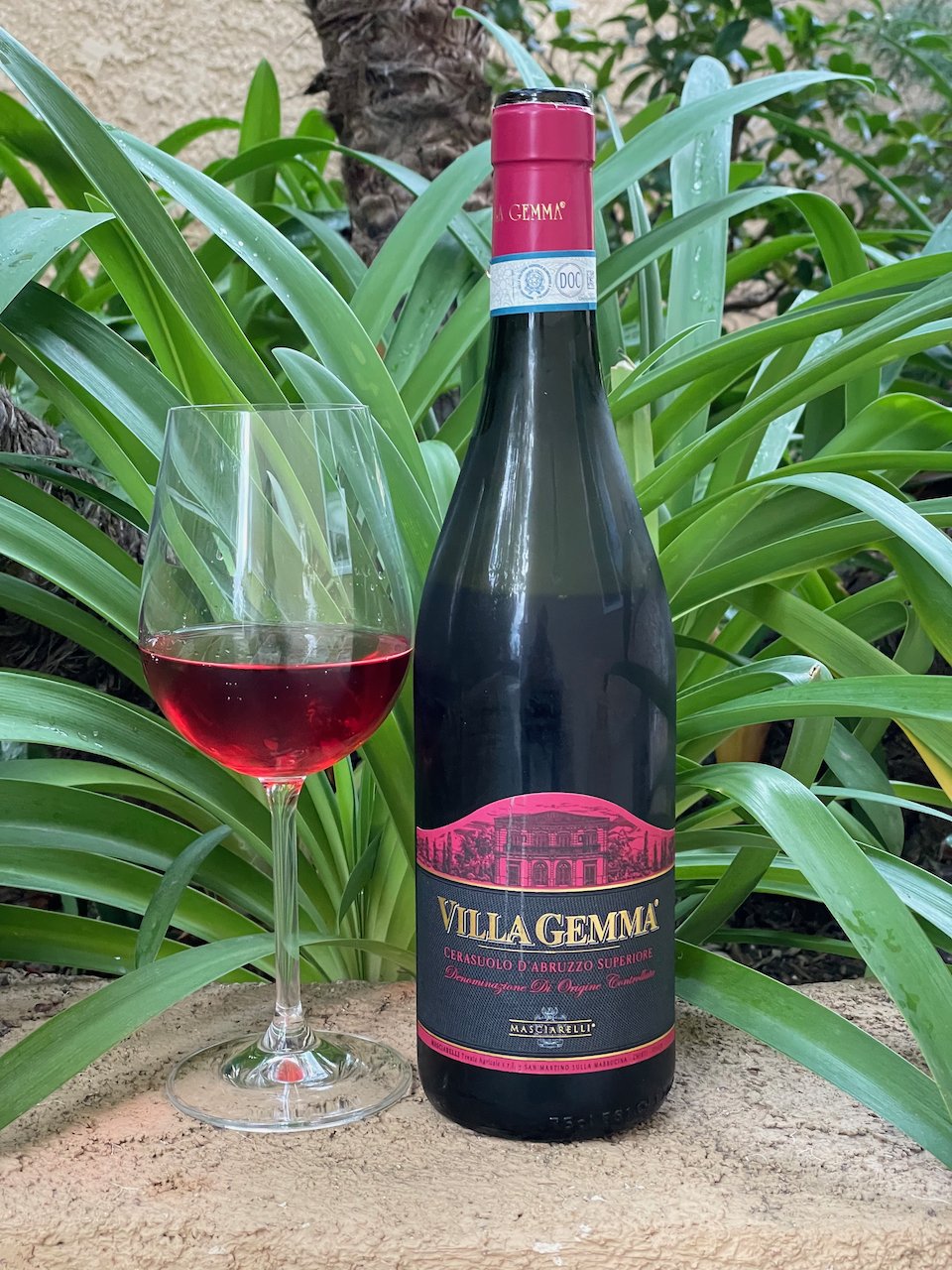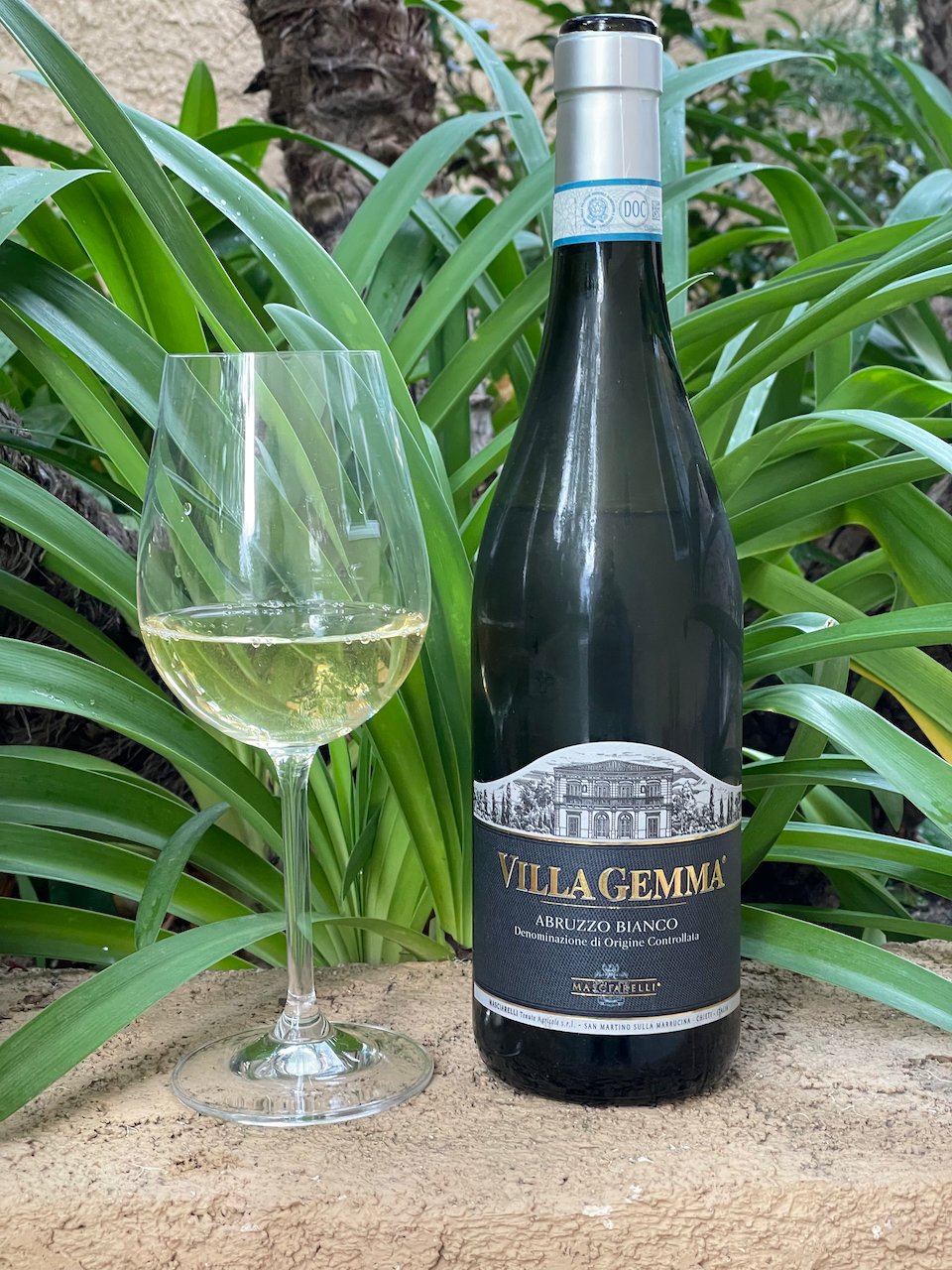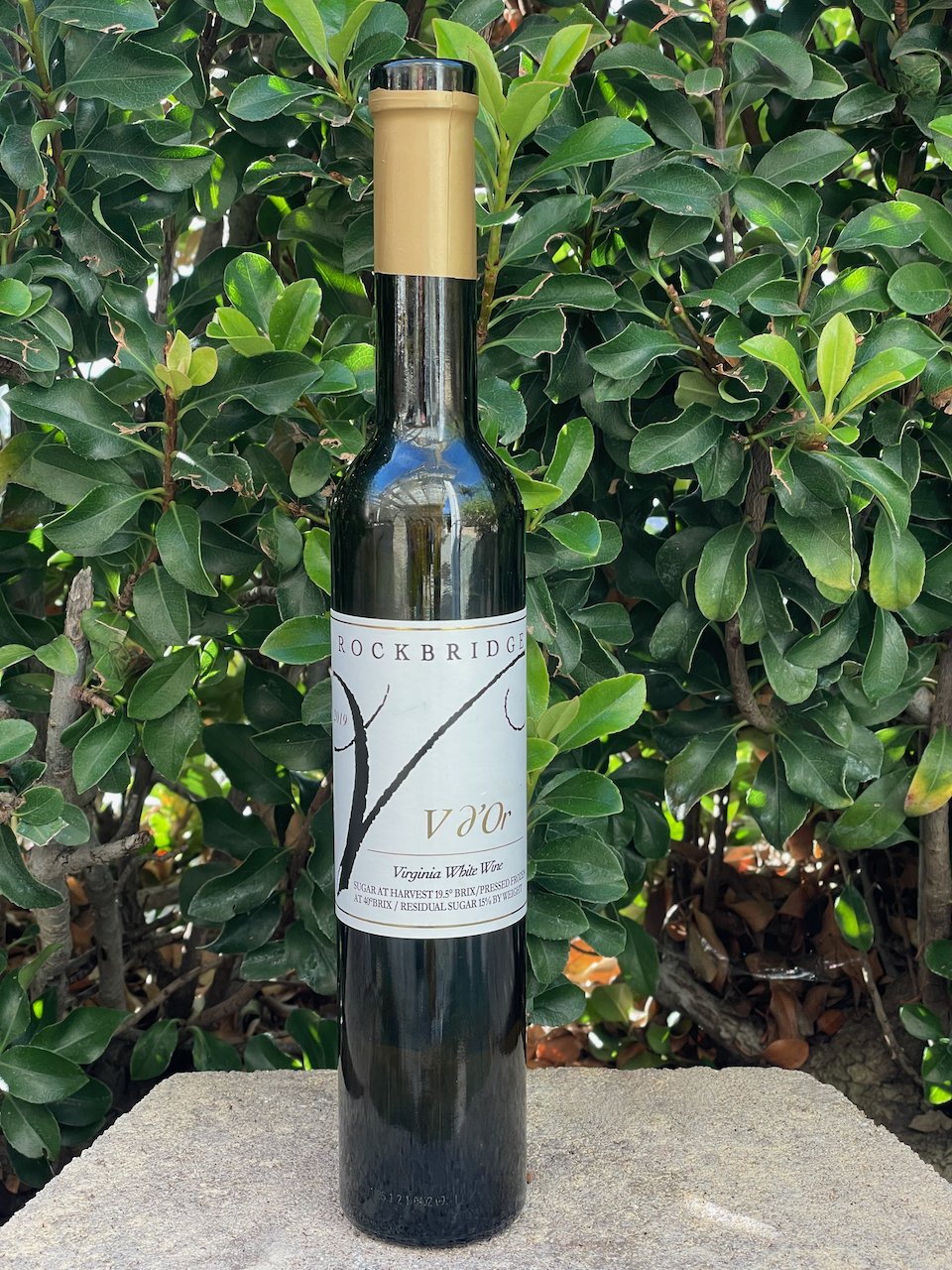2023 Domaine Bousquet Organic Rosé ($13)
Domaine Bousquet´s Organic varietal series comprises a blend of estate and purchased organic fruit from the Uco Valley in the high Andean foothills of Argentina.
The grapes benefit from huge day/night temperature swings, achieving ripeness while retaining the juiciness. The wines are produced with a French sensibility and un-oaked to let the fruit shine through.
The grapes, sourced from the Uco Valley, are harvested early in the morning to preserve the freshness of the fruit. They are then fermented in stainless steel with selected yeasts at a maximum temperature of 26°C/78.8°F for 10 days.
This rosé is produced from organic grapes consisting of 50% Pinot Noir, 30% Syrah, 10% Pinto Grigio and 10% Viognier. It is pale salmon in color, with delicate red fruit and floral aromas. On the palate it has flavors of soft red fruits that are enhanced by the Syrah, some citrus as well as sweet fruit flavors without being a sweet wine. This rosé has nice acidity and finishes soft. [ABV: 12.5%, RS: 1.27 g/L, pH: 3.28, Acidity: 5.62 g/L]
This Domaine Bousquet Organic Rosé is a delightful sipper on a hot summer day, and a great value too! That makes it a great fit as this week’s Behind the Cork™ Wine of the Week. Cheers!
Disclosure of Wine Sample Submission: I received this sample at no cost for review. The opinions expressed are entirely my own.
Media Sample Provided by Domaine Bousquet
Corvezzo Prosecco DOC Extra Dry Rosé ($13)
Corvezzo (“kor-VETZ-zoh”) is the leading name in organically grown, vegan wines from northeast Italy’s Veneto region.
Family-owned and run, Corvezzo has the largest acreage in Italy of certified organic Glera and Pinot Grigio grapes.
Giovanni Corvezzo, owner/winemaker, believes organic farming gives his wines better balance. According to Giovanni, his wines have not only adapted to organic farming, they have also thrived, becoming stronger, with better balance and producing higher quality fruit.
Corvezzo Prosecco Rosé is made with organic & vegan grapes consisting of 85% Glera and 15% Pinot Nero (Pinot Noir). It is produced via the Charmant Method with Fermentation lasting 60 days.
This Corvezzo Prosecco Rosé is pale salmon in color. On the nose it has very delicate fruit aromas of melon, strawberry, raspberry and floral notes. On the palate this Prosecco is light-bodied with citrus notes of grapefruit and strawberry, good acidity and finishes dusty dry. [ABV: 11.5, RS: 12 g/L]
Corvezzo Prosecco Rosé is certified fully organic in Europe, covering both viticulture and production in the winery. But, because of a difference in regulations, U.S. labels state that it is “Made with organic & vegan grapes.” Regardless, this Corvezzo Prosecco Rosé is light and tasty and perfect for sipping during these warm summer months. And, it this week’s Behind the Cork™ Wine of the Week! Cheers!
Disclosure of Wine Sample Submission: I received this sample at no cost for review. The opinions expressed are entirely my own.
Media Sample Provided by Corvezzo
Fiol Rosé Prosecco ($22)
FIOL(FEE-yol) Prosecco DOC Rosé is a new Prosecco that launched in the U.S. just in time for summer!
More than just another Prosecco, FIOL Prosecco DOC Rosé is a sophisticated, distinctive Prosecco with a big personality. Their goal was to produce Prosecco in the authentic style, from the original Prosecco heartland in Treviso, before Prosecco became trendy. A Prosecco that goes back to its roots, reminding us all why Prosecco went on to take center stage in sparkling wines and why everyone has fallen in love with it.
Behind FIOL are childhood friends Gian Luca Passi and Giovanni Ciani Bassetti, whose families have lived and farmed in the Prosecco heartland of Treviso for generations.
FIOL Prosecco DOC Rosé is produced using the Charmat Method, in Stainless Steel tanks, to preserve the fresh and vibrant flavors using 85% Glera and 15% Pinot Noir grapes that are fermented for a minimum of 60 days.
This FIOL Prosecco is a beautiful pale salmon color with subtile aromas of strawberry and raspberry from the Pinot Noir that go nicely with the lemon and white flower aromas of the Glera. On the palate, this Prosecco also has delicate notes of the strawberry along with the light bubbles and crisp acidity. [ABV: 11%, RS: 13 g/l]
This FIOL Prosecco Rosé is great as an aperitif, along with everyday meals or a real treat for special occasions. And, at this price, is a great value! That makes it the perfect fit as this week’s Behind the Cork™ Wine of the Week! Cheers!
Disclosure of Wine Sample Submission: I received this sample at no cost for review. The opinions expressed are entirely my own.
Media Sample Provided by Fiol Prosecco DOC
Domaine Bousquet Sparkling Rosé ($13)
Domaine Bousquet was founded on virgin land in 1997 in the Gualtallary sub-zone of Tupungato in Mendoza’s Uco Valley in Argentina.
Today, the estate, run by daughter Anne Bousquet and husband Labid al Ameri, is Argentina’s largest exporter of wines made from certified organic & biodynamic grapes.
All wines are made from 100% certified organic fruit grown at a cool 4,000-foot-high altitude and crafted with a French winemaking sensibility.
This Domaine Bousquet Sparkling Rosé is produced from 75% Pinot Noir and 25% Chardonnay grapes that are hand harvested. The first fermentation took place for 15 days, while the second fermentation to produce the carbonation, occurs in a stainless steel tank (Charmat Method), and lasts for about 30 days.
The Domaine Bousquet Sparkling Rosé is pale salmon in color with delicate aromas of cherry along with floral notes. On the palate, it is light-bodied, dry (8.1 gm/L RS) with tiny bubbles, having red fruit flavors of cherry and raspberry. It finishes dusty dry with just a hint of tartness.
Domaine Bousquet Sparkling Rosé is great for a summer brunch, a cool glass in the afternoon, and pairs with most lighter-fare meals. And, at this price, makes it a great fit as this week’s Behind the Cork™ Wine of the Week. Cheers!
Disclosure of Wine Sample Submission: I received this sample at no cost for review. The opinions expressed are entirely my own.
Media Sample Provided by Domaine Bousquet
Mosketto Delicate Sweet Pink ($11.99) — Italians love to start off an evening, especially at a social gathering, with a glass of this delicious pink bubbly wine. It really doesn’t matter what time of year it is, the wine’s presence puts everyone in a good mood. The pleasant bubbles in this wine come from a natural carbonation process without the addition of CO2 or artificial flavors. It is produced in Italy from Brachetto and Moscato grapes.
This Mosketto is salmon in color with very delicate aromas. On the palate it has sweet flavors of white cherry and peach. At 5% Alcohol by volume (ABV), this is indeed a light and refreshing wine to enjoy throughout the summer (or anytime!).
Art of Earth Riesling ($11.99) — Any time is the right time for a Riesling. Many wine lovers claim, however, that if there is one wine that is considered to be the best for warm weather, it has to be Riesling.
This Riesling is from the Reinhessen QBA in Germany and is produced in the dry, trocken style. It is pale gold in color with delicate aromas that include nectarine and citrus blossom. On the palate, this off-dry wine has flavors of green apple and pineapple with good acidity and finishes bright with some minerality.
This one is Gluten Free, Non-GMO, Organic, Vegan.
Artigiano Peach Bellini ($12.99) — It is said that Cipriani in Beverly Hills could only serve the Bellini during the summer months of the early 1900s, but nowadays this cocktail can be enjoyed year-round. A comparable alternative to the mimosa, Bellinis make an excellent brunch drink because of their fruit juice and light sparkling wine flavor.
This Belinni is from Spain and made from a blend of 100% organic white wine and peach puree. It’s got big peach flavor and is lightly carbonated. This is a sweet one with just 6% ABV.
With these hot summer months, these three wines are perfect to enjoy with friends and family. And, at these very affordable prices, make them great fits as the Behind the Cork™ Wines of the Week. Cheers!
Disclosure of Wine Sample Submission: I received these samples at no cost for review. The opinions expressed are entirely my own.
Media Samples Provided by Mack & Schühle
9diDANTE Vermouth di Torino Superiore IGP
9diDANTE (“Nove di Dante” or Nine di Dante) vermouths are made at the historic Dr. M. Montanaro Distillery, just five miles from the town of Barolo, the heart of Piedmontese winemaking in Italy. They are a craft operation with just seven full-time employees working in the region’s oldest grappa di Barolo distillery dating from 1885.
In its name, “Dante” refers to Dante Alighieri, author of La Divina Comedia (1320), a revolutionary work in its day.
Vermouth di Torino Superiore IGP guarantees that a minimum 50% of base wine comes from Piedmont, and stipulates a minimum alcohol content of 17% alcohol. At 9diDANTE, 100% of the base wine and at least a third of the herbs (including wormwood) are sourced from the surrounding DOC vineyards and hillsides at their home in Alba.
Their production is done in six steps: (1) Acquire the wine, (2) add spirit, (3) add selected herbs and spices individually macerated in alcohol, (4) let the vermouth rest for one and two months, (5) filter and (6) bottle.
Served over ice with a twist of Orange peel
9diDANTE Inferno Rosso Vermouth di Torino Superiore IGP ($32)
This Vermouth is produced from a 50/50 blend of Piedmont DOC Dolcetto (Dol-CHET-oh), a red wine grape, for structure and color, and Cortese (kort-tay-zay), a white wine grape, for a lively acidity. It has a 75% wine base.
This naturally red vermouth exhibits the sour cherry notes from Dolcetto, followed by notes of orange zest, forest fruits and cardamom.
INFERNO is bright ruby in color. On the nose it has notes of cherry from the Dolcetto followed by aromas of orange zest, vanilla and fruits of the forest. On the palate is has distinct cherry notes along with cardamom and basil, some sweetness and finishes with a slight tartness.
Served over ice with a twist of Lemon peel
9diDANTE Purgatorio Extra Dry Vermouth di Torino Superiore IGP ($35)
This Vermouth is produced from 100% Piedmont DOC Arneis (ar-NAYZ), a white wine grape. It has a 84% wine base.
Pergatorio is pale yellow in color. On the nose it has very faint floral notes. On the palate is has characteristic pear and apricot notes of Arneis wines, citrus and herbal notes, with touches of sage, mint and thyme with a refreshing finish.
9diDANTE was developed to drink “da solo,” that is to say straight. Enjoy it lightly chilled, served neat or on the rocks with a twist of orange or lemon, as an aperitivo. It can also be used in a myriad of cocktails. Or, simply check out the 9diDANTE Cocktail Guide on their website.
These craft Vermouths are delicious and very affordably priced. That makes them a great fit as this week’s Behind the Cork™ Wines of the Week. Cheers!
Disclosure of Wine Sample Submission: I received these samples at no cost for review. The opinions expressed are entirely my own.
Media Samples Provided by 9diDante
The González Byass luxury brandy Lepanto is the only Brandy de Jerez produced entirely in Jerez, Spain and the only Gran Reserva Jerez brandy that fully reflects the essence of Jerez.
Distilled in González Byass pot stills in the center of the city, it is made from Palomino grapes grown in Jerez and aged following the traditional Solera system in American oak casks that have previously contained Sherry, which ensures that both quality and flavor remain constant over time.
González Byass has been producing brandy since 1844. Since then the company has continued to purchase new alambiques and pot stills to produce high quality Brandy de Jerez.
Lepanto is distilled in two Charentais pot stills originally from Cognac dating from the 1960s. Following the second distillation the distillate is fractioned into heads, tails and hearts with only the heart, known as holanda in Jerez, being used for Lepanto. [Note that the “Heads” are the spirits from the beginning of the run that contain a high percentage of low boiling point alcohols and other compounds such as aldehydes and ethyl acetate. The “Hearts” are the desirable middle alcohols from the run. Finally, the “Tails” are the distillate containing a high percentage of fusel oil (Fusel is from the German word that means "bad liquor") and little alcohol at the end of the run.]
The brandy is then aged for a minimum of 12 years in American oak casks previously used for aging Sherry. Lepanto Solera Gran Reserva is finished in sweet oloroso casks.
If you are looking for a real treat, give this González Byass Lepanto Solera Gran Reserva Brandy de Jerez a try. It’s super! And, it’s this week’s Behind the Cork™ Wine of the Week. Cheers!
Disclosure of Wine Sample Submission: I received this sample at no cost for review. The opinions expressed are entirely my own.
Media Sample Provided by González Byass
LO-CA organic Chardonnay and Malbec, from Domaine Bousquet in Uco Valley Argentina, are feel-good, taste-good wines with more altitude, attitude, and fewer calories.
The name, LO-CA, is a play on “low-calorie,” but Loca also means “crazy” in Spanish. So, these LO-CA wines are low-calorie, low-alcohol, low-sugar, vegan, gluten-free, USDA-certified organic, Regenerative Organic Certified™, and Eco cert-approved – how crazy is that!
2023 Domaine Bousquet LO-CA Organic Chardonnay ($14)
This LO-CA wine is produced from 100% Chardonnay grapes that were harvested about two months earlier than for standard bottlings. It was then fermented in stainless steel tanks for 12-17 days. Bottling followed shortly after to ensure peak freshness.
It is medium gold in color with medium aromas of tropical fruit. On the palate it has flavors of green apple and lime with crisp acidity. Alcohol: 9.5% Acidity: 7.72 gm/L, pH: 3.21, Residual Sugar: 1.21 gm/L, Calories:75 per 5 oz serving
2023 Domaine Bousquet LO-CA Organic Malbec ($14)
This LO-CA wine is produced from 100% Malbec. The grapes were harvested about two months earlier than for standard bottlings. It was fermented in stainless steel tanks for 12-17 days. Bottling followed shortly after to ensure peak freshness.
It is medium ruby in color with aromas of red fruits. On the palate, this Malbec has bright red fruit flavors including cranberry. It has medium tannin and acidity and finishes bright with some tartness. Alcohol: 9.5% Acidity: 5.62 gm/L, pH: 3.62, Residual Sugar: 1.21 gm/L, Calories:79 per 5 oz serving
These LO-CA wines from Domaine Bousquet are easy to drink, light and refreshing wines that can be enjoyed at any time. And, at the price, they fit right in as the Behind the Cork™ Wines of the Week! Cheers!
Disclosure of Wine Sample Submission: I received these samples at no cost for review. The opinions expressed are entirely my own.
Media Samples Provided by Domaine Bousquet
Danaus Red Blend ($13)
Danaus originates from the Costers del Segre DO in the Lleida province of Catalunya in northeast Spain.
It gets its name, Danaus Plexippus (i.e., “sleepy transformation” in ancient Greek), from the scientific name for the monarch butterfly named for the monarch King William III of England.
It is produced from organic grapes: 45% Tempranillo, 45% Garnacha Tinta (Grenache) and 10% Cabernet Sauvignon.
It underwent cold maceration before being fermented for 15 days. It was then aged for 4 months in 300 liter French oak barrels.
Danaus red wine is medium purple in color with aromas of red fruit (cherry, plum, berry) along with floral notes and sweet tobacco leaf. On the palate, this medium-full bodied wine has bright red fruit flavors of cherry and cranberry while the Cabernet Sauvignon adds some extra depth and character. Its tannins are medium as is its acidity. It finishes lean with fresh fruit flavors. [ABV: 14%]
Danaus red wine is widely available (Distributed in AR, AZ, CA, CT, DC, DE, FL, KS, LA, MD, ME, MI, NJ, NY, OR, VT, WA) and at this very affordable price, a great fit as this week’s Behind the Cork™ Wine of the Week. Cheers!
Disclosure of Wine Sample Submission: I received this sample at no cost for review. The opinions expressed are entirely my own.
Media Sample Provided by Domaine Bousquet
2021 Domaine Bousquet Cameleon Signature Organic Cabernet Sauvignon ($20)
Like its namesake, Cameleon is the embodiment of adaptation to the environment. The label symbolizes the story of the Bousquet family, a fourth-generation family that left their native France after a long worldwide search for an idyllic wine growing region. Their search came to a natural conclusion in Tupungato where the Bousquet family tailored their extensive winemaking knowledge to the carefully chosen land. The European grapes such as Chardonnay, also adapted to the characteristics of the fertile Argentinean soil, creating the distinctive wine the family had sought.
This Cameleon Signature Organic Cabernet Sauvignon was produced form 85% Cabernet Sauvignon and 15% Malbec. They were hand harvested from organic vineyards and underwent cold maceration for 48 hours. It was then fermented with selected yeast for 10 days followed by 10 days of additional maceration. It underwent 100% malolactic conversion and was aged in contact with French oak for 6 to 8 months.
This wine is deep purple in color. On the nose it has medium-intensity notes of black fruit with herbal notes, some spiciness and a bit of dried tobacco. On the palate, this is a full-bodied Cab with flavors of black berry, black cherry and a hint of blueberry. This young Cab has bold tannin right out of bottle that settles down nicely after 1+ hours of decanting. It finishes smooth with just a bit of tartness. [ABV: 14.5%, Acidity: 5.55 gm/L, pH:3.67, Residual Sugar: 2.36 g/L]
This Cameleon Signature Organic Cabernet Sauvignon from Domaine Bousquet is big and bold and pairs well with grilled beef. And, at this great price, it’s this week’s Behind the Cork™ Wine of the Week. Cheers!
Disclosure of Wine Sample Submission: I received this sample at no cost for review. The opinions expressed are entirely my own.
Media Sample Provided by Domaine Bousquet
2022 Domaine Bousquet Cameleon Signature Organic Chardonnay ($15)
Like its namesake, Cameleon is the embodiment of adaptation to the environment. The label symbolizes the story of the Bousquet family, a fourth-generation family that left their native France after a long worldwide search for an idyllic wine growing region. Their search came to a natural conclusion in Tupungato where the Bousquet family tailored their extensive winemaking knowledge to the carefully chosen land. The European grapes such as Chardonnay, also adapted to the characteristics of the fertile Argentinean soil, creating the distinctive wine the family had sought.
This Cameleon Signature Organic Chardonnay is produced from 100% Chardonnay grown in vineyards in the Uco Valley at the foot of the Andes at 4000 feet. It spent six months in contact with French oak. It is pale gold in color with delicate aromas of apple and crème brûlée. On the palate, this medium-light bodied Chardonnay has flavors of yellow apple, baked pear and pineapple. It finishes bright with a hint of tartness.
This Domaine Bousquet Cameleon Signature Organic Chardonnay is unique in that its fruit flavors and mouthfeel are somewhere between an un-oaked and a lightly-oaked Chardonnay. Perfect for the coming warm weather months. For these reasons, and its great price, Cameleon is featured as this week’s Behind the Cork™ Wine of the Week. Cheers!
Disclosure of Wine Sample Submission: I received this sample at no cost for review. The opinions expressed are entirely my own.
Media Sample Provided by Domaine Bousquet
2022 Domaine Bousquet Cabernet Sauvignon ($13)
A 1990 vacation in Argentina was all it took. For third-generation winemaker Jean Bousquet, it was love at first sight. The object of the Frenchman’s desire: the Gualtallary Valley, a scenic, remote, arid terrain high in the Tupungato district of the Uco Valley in Argentina’s Mendoza region, close to the border with Chile. Here, where the condors fly and not a vine in sight, Bousquet discovered his dream terroir, an ideal location in which to nurture organically-grown wines.
Jean Bousquet reckoned he’d found the perfect blend between his French homeland and the New World with the sun, with potential for high natural acidity in wine grapes as well as the potential for relatively fruit-forward wines.
It worked out well. Domaine Bousquet now produces 4 million liters a year and export 95% of its volume to more than 50 countries. With their own import companies in the USA, Europe, and Brazil, Domaine Bousquet currently ranks in the top 20 Argentine wineries in terms of exports and is the leader in organic wine.
This 2022 Domaine Bousquet Cabernet Sauvignon is made from 100% organic grapes from Tupungato Uco Valley Mendoza Argentina. They were fermented with selected yeasts for 10 days. It is deep ruby in color with aromas of black plum, black berry and raspberry along with delicate spicy notes. On the palate this wine is medium bodied with medium tannin and acidity. It finishes light with subtle spicy notes. [ABV: 14%, Acidity: 5.23 g/L, pH: 3.7, Residual Sugar: 2.09 g/L]
If a ‘big’ Cab is not for you, this wine is one that you may enjoy. It has more of a bright fruit focus on the palate and ends easy without heavy tannin.
This organically grown Cabernet Sauvignon from Domaine Bousquet is great tasting and a super value which makes it a great fit as this week’s Behind the Cork™ Wine of the Week. Cheers!
Disclosure of Wine Sample Submission: I received this sample at no cost for review. The opinions expressed are entirely my own.
Media Sample Provided by Domaine Bousquet
2022 Domaine Bousquet Malbec ($13)
A 1990 vacation in Argentina was all it took. For third-generation winemaker Jean Bousquet, it was love at first sight. The object of the Frenchman’s desire: the Gualtallary Valley, a scenic, remote, arid terrain high in the Tupungato district of the Uco Valley in Argentina’s Mendoza region, close to the border with Chile. Here, where the condors fly and not a vine in sight, Bousquet discovered his dream terroir, an ideal location in which to nurture organically-grown wines.
Jean Bousquet reckoned he’d found the perfect blend between his French homeland and the New World with the sun, with potential for high natural acidity in wine grapes as well as the potential for relatively fruit-forward wines.
It worked out well. Domaine Bousquet now produces 4 million liters a year and export 95% of its volume to more than 50 countries. With their own import companies in the USA, Europe, and Brazil, Domaine Bousquet currently ranks in the top 20 Argentine wineries in terms of exports and is the leader in organic wine.
This 2020 Domaine Bousquet Malbec is produced from 100% organic grapes from the foothills of the Andes at 4000 feet. It was fermented with selected yeasts for 10 days and was un-oaked. It is deep purple in color, with aromas of dark red and black fruits. On the palate, this Malbec is medium-full bodied with flavors of black cherry, boysenberry and red plum. It has medium tannin and medium-high acidity and finishes with spicy notes.
This organically grown Malbec from Domaine Bousquet is great tasting and a super value which makes it a great fit as this week’s Behind the Cork™ Wine of the Week. Cheers!
Disclosure of Wine Sample Submission: I received this sample at no cost for review. The opinions expressed are entirely my own.
Media Sample Provided by Domaine Bousquet
White Wines from Domaine Bousquet
Embraced for their freshness, vibrant aromatics and fruit-forward qualities, wines from the Gualtallary zone of Tupungato in Mendoza’s Uco Valley have become “must-haves” for Argentine connoisseurs. With altitudes ranging up to 5,249 feet, Gualtallary occupies the highest extremes of Mendoza’s viticultural limits.
Domaine Bousquet, an early pioneer in this high-altitude sub-region of the Uco Valley, stands out for its singular reliance on eco-friendly organic fruit. And their prices are very competitive!
Today, Domaine Bousquet is housed in a striking modern winery, complete with a hospitality area and restaurant, and the property accounts for approximately 600 acres planted under vine.
2023 Domaine Bousquet Sauvignon Blanc ($13) - The organically grown 100% Sauvignon Blanc grapes used produce this wine were sourced from the Uco Valley. They were harvested early in the morning to preserve the freshness of the fruit. They were then fermented in stainless steel with selected yeasts for 10 days. The wine is un-oaked, to highlight the fruit and its varietal expression. This wine is medium yellow with green hints. Upon opening the bottle and pouring a glass, there were tiny bubbles observed in the bottle and in the glass. On the nose this wine has medium-high notes of citrus, lime and grass. On the palate, this light-bodied wine has flavors of green apple and bright acidity. It finishes smooth with a very slight sweetness. (ABV: 12.5, Acidity: 5.32 g/L, pH: 3.26, RS: 1.03 g/L)
2023 Domaine Bousquet Unoaked Chardonnay ($23) - The organically grown 100% Chardonnay grapes used produce this wine were sourced from the Uco Valley. They were harvested early in the morning to preserve the freshness of the fruit. They were then fermented in stainless steel with selected yeasts for 10 days. This Chardonnay is un-oaked, to highlight the fruit and its varietal expression. This wine is medium gold in color with a subtle aroma of apple. On the palate, this medium-bodied un-oaked Chardonnay has crisp flavors of green apple and tangerine with good acidity. It finishes with the bright tartness of a green apple. If you are a Sauvignon Blanc lover, you should check this one out! (ABV: 13, Acidity: 5.55 g/L, pH: 3.30, RS: 1.76 g/L)
Both of these organically grown white wines from Domaine Bousquet are great tasting and a super value which makes them a great fit as this week’s Behind the Cork™ Wines of the Week. Cheers!
Disclosure of Wine Sample Submission: I received these samples at no cost for review. The opinions expressed are entirely my own.
Media Samples Provided by Domaine Bousquet
Vermut Flores Rosé ($19)
As was noted in a previous blog, vermouth is a wine - a fortified wine. A fortified wine that is infused with a mixture of botanical products including fruits, herbs, spices and roots. After the wine is aromatized and fortified, the Vermouth may be bottled dry, or sweeteners such as sugar may be added to create the sweet style of Vermouth, like this one.
This Basta Spirit Flores Rosé vermouth is from Uruguay and is made from Tannat grapes that are pressed and left in brief contact with the skins to create a rosé which acts as the base wine for the Vermouth.
Flores is a family of vermouth based on Tannat wine. Their Rojo and Rosado varieties are produced from Tannat. Albariño wine is used for the Flores Blanco Vermouth variety.
Vermut Flores Rosé is produced from a combination of twenty-seven (yes, 27!) different botanicals that make up its formula. Among them are Wormwood, Cardamom, Gentian, Quina and Coriander.
It was included as one of the Wine Enthusiast 2022 Top 100 Spirits of the Year as well as receiving a 94-point rating!
Vermut Flores Rosé is a bright and crisp vermouth. You can drink it alone, with a slice of lemon, lime, or orange, with or without olives, with or without tonic water. But, always include a good amount of ice!
Basta Spirits’ Vermut Flores is this week’s Behind the Cork™ Wine of the Week. Cheers!
Disclosure of Wine Sample Submission: I received this sample at no cost for review. The opinions expressed are entirely my own.
Media Sample Provided by Basta Spirit who Produces Vermut Flores
2018 Alto de la Ballena Reserva Tannat-Viognier ($26)
Alto de la Ballena is a small winery founded by husband and wife Paula Pivel and Alvaro Lorenzo.
They began its plantations in 2001 with first harvest in 2005 and the first wines were presented to the market in 2007.
Located in the Sierra de la Ballena, 15 km (9.3 miles) from the coast, Alto de la Ballena combines oceanic air and mountain soils. There are just over 8 hectares (~20 acres) of Merlot, Tannat, Cabernet Franc, Syrah and Viognier, for a limited production of high quality wines.
This wine is produced from both Tannat (85%) and Viognier (15%) grapes. This blending of a red wine grape with a white wine grape has many benefits. Both grape-types are hand picked and crushed into the same vat where, after macerating at low temperature for three days, they co-ferment. Then, the wine is then aged for nine months in American oak barrels. (14% ABV, Total Acidity: 6.1 g/L, pH: 3.4, RS: 1.9 g/L)
This 2018 Alto de la Ballena wine is medium ruby in color with medium aromas of red fruit and floral notes. On the palate this medium-full bodied wine has nice flavors of black and red fruit. The typically big and bold Tannat profile is definitely softened by the addition of the Viognier. But, it softens even more in the decanter for an hour. It has a medium-long finish.
This 2018 Alto de la Ballena Reserva Tannat-Viognier blend presents Tannat uniquely and is a must-try for Tannat lovers. And, at this price, it’s a great fit as this week’s Behind the Cork™ Wine of the Week. Cheers!
Disclosure of Wine Sample Submission: I received this sample at no cost for review. The opinions expressed are entirely my own.
Media Sample Provided by Alto de la Ballena Bodega Y Viñedos
2020 Pisano RPF Tannat ($24)
Pisano is part of a group of small family wineries in Uruguay with an artisan tradition of making wines that reflect the character of the land and the people who make them. Pisano is located on the ‘Rio de la Plata’ near the Atlantic Ocean in southern Uruguay.
At Pisano, family hands cultivate the grapes, taking away excess crops in productive years, taking leaves away to expose the bunches to the sun for better maturation and skin color.
The RPF (Reserva Personal de la Familia) wines were created with the aim of keeping limited quantities for the family’s personal consumption. By giving some bottles to their friends, more people got to know about the RPF wines. These are now Pisano’s most exclusive and prestigious wines.
This 2020 Pisano RFP Tannat is produced from 100% Tannat that is grown in the City of Progreso, Department of Canelones, in Uruguay. It was aged 10-12 months in French oak barrels and approximately 6 months in the bottle.
This Pisano RFP Tannat is deep ruby in color with aromas of red and black fruits, notes of spice and a hint of bitter chocolate. On the palate has flavors of blackberries and raspberries, medium tannin and finishes balanced with jammy flavor. I expected that this Tannat would need considerable decanting time but was surprisingly drinkable right out of the bottle. It finishes very nicely.
If you are not familiar with the wines of Uruguay you really need to seek this one out. Pisano is making wines of excellent quality at very affordable prices. That make this Pisano RPF Tannat a great fit as the Behind the Cork™ Wine of the Week. Cheers!
Disclosure of Wine Sample Submission: I received this sample at no cost for review. The opinions expressed are entirely my own.
Media Sample Provided by Pisano Wines
2020 Bodega Cerro del Toro Tannat ($25)
Bodega Cerro del Toro is a Uruguayan wine project that was born in 2016 with the aim of producing high-quality wines in a privileged location on the Maldonado coast of Uruguay.
The grapes for this Tannat were grow at the foot of Cerro del Toro (meaning ‘Bull Hill’), just over one mile from the coast in a microclimate with a deep influence of the sea breeze.
This wine was produced from 100% Tannat grapes that were destemmed and cold soaked for 24 hours. Fermentation was done in stainless steel tanks with selected yeast for 10 days. Pump-overs were carried out to control the desired extraction of aromas and flavors. The wine underwent malolactic conversion and had no contact with oak during aging. Just 8000 bottles were produced.
This 2020 Cerro del Toro Tannat is deep ruby in color with a medium nose of black fruits and some herbal notes. On the palate, this full-bodied wine has big dark fruit and red fruit flavors, medium-high acidity, bold tannin and finishes long with some spiciness.
Cerro del Toro Tannat is yet another fine example of the wines being produced in Uruguay and available throughout the U.S. With this quality and price-point, it’s a great fit as this week’s Behind the Cork™ Wine of the Week. Cheers!
Disclosure of Wine Sample Submission: I received this sample at no cost for review. The opinions expressed are entirely my own.
Media Sample Provided by Bodega Cerro del Toro
2021 Bodega Garzón Tannat Reserva ($18)
Located in the hills eleven miles from the Atlantic Ocean, Bodega Garzón is close to Punta del Este, La Barra and Jose Ignacio in the Maldonado region of southern Uruguay.
In 2018, they were named the New World Winery of the Year by Wine Enthusiast!
Their estate has more than 1,000 small vineyard blocks covering its hillside slopes.
Bodega Garzón Reserva wines are made of grapes harvested and classified by hand that are handled with extra care so they can express the variety and identity character of their terroir.
This 2021 Bodega Garzón Tannat (tahn-naht) Reserva is produced from 100% Tannat that was fermented in cement tanks and then aged 6 to 12 months in 50 HL (1320 gallon) untoasted French oak casks. It is deep ruby in color with aromas of dark fruit and spice. On the palate, this full-bodied Tannat has big flavors of black plum with a hint of raspberry and some spicy notes. It exhibits Tannat’s classic bold tannin, good acidity and a big finish. Note that this wine was decanted for more than one-hour prior to tasting to aid in the softening of the tannin. [ABV: 14%, Acidity: 5.6 g/L, pH: 3.67, Residual Sugar: 5.3 g/L]
Bodega Garzón is certainly one of the biggest if not the biggest producer in Uruguay and is widely available in the U.S. This nicely produced Tannat and its price-point make it a great fit as this week’s Behind the Cork™ Wine of the Week. Cheers!
Disclosure of Wine Sample Submission: I received this sample at no cost for review. The opinions expressed are entirely my own.
Media Sample Provided by Bodega Garzón via Creative Palate Communications
Ameri by Domaine Bousquet
Named for co-owner Labid Al Ameri, Domaine Bousquet’s “Ameri” wines are only made in exceptional years and exclusively from selected grape clusters harvested from the estates’ best vineyard.
2020 Ameri Red Blend ($27)
Ameri Red Blend debuted with the 2011 vintage. Each bottle as been individually numbered since 2018. This wine is produced from 60% Malbec, 20% Cabernet Sauvignon, 10% Syrah, and 10% Merlot. It underwent a four-day cold maceration followed by a 14-day fermentation in oak with selected yeasts. This is followed by another 20-day maceration and malolactic conversion. Finally, it is aged 16 months in French oak before bottling and release. It is medium purple in color with soft aromas of dark fruit and cedar. On the palate, this full-bodied wine has good flavors of rich black and red fruits and finishes with nice sweet and spicy notes. (ABV: 14.5%, Total Acidity: 5.17 gm/L, pH: 3.68, Residual Sugar: 1.74 gm/L)
2020 Ameri Malbec ($27)
The Ameri Malbec is a new development at Domaine Bousquet. It started with the 2019 vintage when Domaine Bousquet winemaker Rodrigo Serrano determined that the Ameri Red Blend component wines were presenting so well that the time had come to showcase them individually, starting with the Malbec. It is medium purple in color with pleasant aromas of black berry, plum and red fruit along with sweet tobacco. On the palate, this medium-full-bodied wine exhibits nice rich dark fruit flavors, medium tannin and acidity and finishes smooth, soft and lean with hints of cocoa. (ABV: 14.5%, Total Acidity: 5.25 gm/L, pH: 3.67, Residual Sugar: 1.91 gm/L)
Domaine Bousquet is making great wines from their vineyards in Argentina, but these two Ameri wine are yet another step-up in excellence. And, at these prices, these wines are a great fit as Behind the Cork™ Wines of the Week. Cheers!
Disclosure of Wine Sample Submission: I received these samples at no cost for review. The opinions expressed are entirely my own.
Media Samples Provided by Domaine Bousquet, Origins Organic Imports and Creative Palate Communications
2020 Muse Vineyards Petit Verdot ($41)
Muse Vineyards is located in the heart of the Shenandoah Valley, just 90 minutes from Washington DC.
Muse Vineyards sits at an elevation of 1,000 feet and rests on Virginia shale and rocky red clay soils. The top vineyard sits on a terrace formed millions of years ago by the Shenandoah River that today flows one hundred feet below.
Muse’s proprietors are husband and wife, Robert Muse and Sally Cowal. Robert is an international lawyer who (as an Arizonan) trained as a barrister in England. Sally is a former United States ambassador who is now Senior Vice President of Global Cancer Control at the American Cancer Society. They established Muse Vineyards in 2005.
This Muse Vineyards Petit Verdot is produced from 100% Petit Verdot. It is deep ruby in color with a medium-high nose that includes black cherry and floral notes of violets and lilac. On the palate, this full-bodied wine is dry (13.5% ABV) with medium tannin and medium acidity, has rich dark fruit flavors and a nice spicy-jammy finish.
This 2020 Muse Vineyards Petit Verdot was a recent 4th place award winner in the Shenandoah Cup Awards. This is a very nice wine at a very affordable price which makes it a great fit as this week’s Behind the Cork™ Wine of the Week. Cheers!
Disclosure of Wine Sample Submission: I received this sample at no cost for review. The opinions expressed are entirely my own.
Media Sample Provided by Muse Vineyards via the Shenandoah Valley Wine Growers Association and Donna White Communications
Wines of Bluestone Vineyards
Bluestone Vineyard is named after the "bluestone" (a type of limestone) that is a main component within the local soil. It is a family owned and operated vineyard and winery in the Shenandoah Valley AVA.
Curt and Jackie Hartman began planting grapes in 2003 to make wine for personal use. In 2007 they decided to make the vineyard a business. Their two sons are running the winery with Lee Hartman as Winemaker and General Manager and RC Hartman as the Operations Manager. Today, Bluestone Vineyards is producing about 5,000 cases annually.
Each of these two red wines from Bluestone Vineyard recently tied for fourth place in the 2023 Shenandoah Valley Cup.
2021 Bluestone Vineyards Estate Merlot ($26)
This Bluestone Merlot is produced from 100% Merlot grapes that are Estate grown. It is deep garnet in color with aromas of plum, cherry, dried herbs and a hint of smokiness. On the palate, this medium-bodied wine has medium tannin and acidity with flavors of black cherry, white pepper and cedar with a soft-chocolate finish.
2021 Bridgewater Crimson Virginia Red Blend ($26)
The Bridgewater Crimson red blend is made in collaboration with nearby Bridewater College.
This Crimson red blend is a traditional Bordeaux blend of Petit Verdot (50%), Merlot (33%) and Cabernet Franc (17%). It is deep garnet in color with bright red fruit aromas. On the palate, this full-bodied wine has good complexity with rich red fruit flavor and peppery notes. It finishes with spicy notes.
The Shenandoah Valley AVA is producing a bunch of great wines and these are two fine examples from Bluestone Vineyard. These award winning wines are a great value and a great fit as this week’s Behind the Cork™ Wines of the Week. Cheers!
Disclosure of Wine Sample Submission: I received these samples at no cost for review. The opinions expressed are entirely my own.
Media Samples Provided by Bluestone Vineyard via the Shenandoah Valley Wine Growers Association and Donna White Communications
2019 Jump Mountain Borderland Red Blend ($27)
From the Shenandoah Valley AVA, Jump Mountain Borderland red blend is an award-winning wine having received 1st place in the Shenandoah Cup Awards!
Approved in 1982 as Virginia’s first American Viticultural Area, the Shenandoah Valley AVA is located in the Appalachian region of the eastern United States covering the land along the western edge of Virginia and spilling into the easternmost portion of West Virginia.
Bounded by the Blue Ridge Mountains to the east and the Allegheny Mountains to the west, these two ranges create a specific mesoclimate for the valley between them, which itself ranges from 500 to 1,800 feet above sea level, protecting it from storms from the west and rain-bearing winds blowing in from the Atlantic coast, 100 miles east.
Protected by the sandstone knob of Jump Mountain, the micro-climate and soils found at Jump Mountain Vineyards create conditions conducive to growing vinifera grape varieties.
This Jump Mountain Borderland red blend is produced from 50% Tannat, 25% Cabernet Sauvignon and 25% Cabernet Franc. It is deep ruby in color with big aromas of rich dark fruit. On the palate, this blend has wonderful flavors of cherry and raspberry with medium tannin and a balanced soft finish. The three ‘big’ red grapes used in this blend might typically need a good hour or more in the decanter but the 2019 Borderland was great right after pulling the cork.
Being a 1st place wine, and only having produced 50 cases, this Jump Mountain Borderland red blend may be tough to find. But if you are able to find it, pick up a couple - it’s super! And, at the price, it’s definitely a perfect fit as this week’s Behind the Cork™ Wine of the Week. Cheers!
Disclosure of Wine Sample Submission: I received this sample at no cost for review. The opinions expressed are entirely my own.
Media Sample Provided by Jump Mountain Vineyards via the Shenandoah Valley Wine Growers Association and Donna White Communications
Behind the Cork™ - Vilarnau Cava is Perfect for Valentine's Day
February 14, 2024
Valentine’s Day is the perfect time for sparkling wine. And, Cava is great choice.
These two wonderful Cavas are from Vilarnau in Barcelona Spain. The name comes from the old Vilarnau castle which can be found on the banks of the river Anoia and which formed part of the Subirats castle, where the vineyards can be found today. The winery is a small, artisanal, hand crafted Cava house located outside of Barcelona that dates back to 1949. Made in the traditional méthode champenoise, the Vilarnau bottles honor their Catalan roots with wrapping that reflects the beautiful avant-garde imagery of Antoni Gaudí.
Vilarnau Brut Reserva NV ($15.99) This Brut Cava is made from three varietals: 50% Macabeo, 35% Parellada, 15% Xarel.lo. Each varietal is fermented separately. The first fermentation takes place over 30 days before the wines are blended. The second fermentation occurs the traditional way, in the bottle, where the yeast turns the wines into Cava with its characteristic bubbles. On the palate, this Brut Cava has flavors of apple, lemon, and white pears along with bright acidity. It is classified as a "Reserva" because it was aged for more than 15 months in the bottle.
Vilarnau Brut Rosé Delicat Reserva NV ($16.99) This rosé Cava is produced from 85% Garnacha and 15% Pinot Noir. They are fermented separately in stainless steel tanks for 30 days. They are then blended and bottled where they undergo the second fermentation which takes about six weeks. It then stays in contact with the yeast for at least 15 months in the bottle during the aging process which qualifies this Cava as a “Reserva.” This Cava has delicate flavors of ripe strawberries, raspberries and blueberries. It’s smooth, creamy and refreshing.
Vilarnau cavas are imported by González Byass USA, distributed nationally at great prices and are this week’s Behind the Cork™ Wines of the Week.
Happy Valentine’s Day and “Cheers” to raising a delicious glass of Cava!
Disclosure of Wine Sample Submission: I received these samples at no cost for review. The opinions expressed are entirely my own.
Samples Provided by González Byass via Donna White Communications
2021 Jump Mountain Livia Red Blend ($27)
From the Shenandoah Valley AVA, Jump Mountain Livia red blend is an award winning wine having tied for 3rd in the Shenandoah Cup Awards!
Approved in 1982 as Virginia’s first American Viticultural Area, the Shenandoah Valley AVA is located in the Appalachian region of the eastern United States covering the land along the western edge of Virginia and spilling into the easternmost portion of West Virginia.
Bounded by the Blue Ridge Mountains to the east and the Allegheny Mountains to the west, these two ranges create a specific mesoclimate for the valley between them, which itself ranges from 500 to 1,800 feet above sea level, protecting it from storms from the west and rain-bearing winds blowing in from the Atlantic coast, 100 miles east.
Protected by the sandstone knob of Jump Mountain, the micro-climate and soils found at Jump Mountain Vineyards create conditions conducive to growing vinifera grape varieties.
This Jump Mountain Livia Red Blend is produced from 60% Refosco, 20% Cabernet Franc, 15% Lagrein and 5% Sagrantino. This wine is deep ruby in color with aromas of red fruit, some smoke from the Lagrein and Refosco and a bit of earthiness. On the palate, this full-bodied wine has nice juicy fruit flavors of red cherry and raspberry. The 2 gm/L of residual sugar give the fruit flavors a pop. The fruit flavors on the finish are quite nice. Overall, this was a surprisingly good red blend!
Jump Mountain Vineyards states that this wine is named for Livia Drusilla Augusta (58 BC - 29 AD), wife of Augustus Ceasar, who proclaimed that Refosco was her favorite wine!
This is a really nice red blend at a very affordable price and this week’s BTC Wine of the Week. Cheers!
Disclosure of Wine Sample Submission: I received this sample at no cost for review. The opinions expressed are entirely my own.
Media Sample Provided by Jump Mountain Vineyards via the Shenandoah Valley Wine Growers Association and Donna White Communications
Behind the Cork™ - Villa Gemma Montepulciano D'Abruzzo Riserva
Masciarelli (Mass-shee-ah-RELL-ee) Winery is located in the Abruzzo region of Italy on the eastern coast, just east of Rome on the Adriatic Sea. It was established in 1981 from the entrepreneurial intuition of Gianni Masciarelli. Today, Miriam Masciarelli (Gianni’s daughter) works with her mother, Marina Cvetić Masciarelli, to run this fabulous family winery that now has 22 labels and seven product lines all sourced from 60 vineyards in all four provinces of Abruzzo. One of their product lines, Villa Gemma, honors the modest family home where Gianni Masciarelli was born.
2018 Villa Gemma Montepulciano D’Abruzzo Riserva ($98)
The grapes for this wine come from the original 12-acre Colle Cave home vineyard dating back to 1930 that is located above and behind the family home in Chieti. Today’s vines are around 30 years old and planted in dense guyot rows to limit yield. They only produce this wine in the best years.
This Masciarelli Villa Gemma Montepulciano D’Abruzzo Riserva is produced from 100% Montepulciano grapes that are fermented in stainless steel. The wine is then aged in French oak barrels for five to six year before being bottled.
This wine is deep ruby in color with a medium nose of rich red fruit. On the palate, this full-bodied wine has rich and complex flavors that include red fruits, dried fruit, pepper and cocoa. It finishes with rich fruit flavors.
Abruzzo is now among the fastest growing regional economies in Italy and Southern Italy’s single most prosperous region. They are also producing some amazing wines. Check out all of Masciarelli’s wines on their website. And, when you can find this wine, splurge! This wonderful Villa Gemma Montepulciano D’Abruzzo Riserva is this week’s Behind the Cork™ Wine of the Week. Cheers!
Disclosure of Wine Sample Submission: I received this sample at no cost for review. The opinions expressed are entirely my own.
Media Sample Provided by Masciarelli Winery
2019 Marina Cvetić Montepulciano d’Abruzzo Riserva ($38)
Masciarelli (Mass-shee-ah-RELL-ee) Winery is located in the Abruzzo region of Italy on the eastern coast, just east of Rome on the Adriatic Sea. It was established in 1981 from the entrepreneurial intuition of Gianni Masciarelli. Today, Miriam Masciarelli (Gianni’s daughter) works with her mother, Marina Cvetić Masciarelli, to run this fabulous family winery that now has 22 labels and seven product lines all sourced from 60 vineyards in all four provinces of Abruzzo. One of their product lines, Marina Cvetić, was named by Gianni in honor is his wife.
This wine is produced from 100% Montepulciano grapes that were harvested from four top “cru” vineyards ranging between 435-1,200 feet in altitude. The fruit from each vineyard was fermented and macerated separately. It was aged 12 months in French barrels of first-use before being bottled. It then underwent further aging in the bottle.
Marina Cvetić Montepulciano is deep ruby red in color. On the nose it has medium notes of red and dark fruit, including dark cherry, along with herbal notes and hints of oak. On the palate, this full-bodied wine is rich and complex with red fruit flavors, dried fruit, some spicy notes, cocoa, and black pepper. It has a medium-long finish.
Masciarelli’s Marina Cvetić Montepulciano is yet another delicious example of the great wines coming from the Abruzzo region of Italy and featured as the Behind the Cork™ Wine of the Week. Cheers!
Disclosure of Wine Sample Submission: I received this sample at no cost for review. The opinions expressed are entirely my own.
Media Sample Provided by Masciarelli Winery
Behind the Cork™ - Villa Gemma Cerasuolo D'Abruzzo Superiore
January 17, 2024
Masciarelli (Mass-shee-ah-RELL-ee) Winery is located in the Abruzzo region of Italy on the eastern coast, just east of Rome on the Adriatic Sea. It was established in 1981 from the entrepreneurial intuition of Gianni Masciarelli. Today, Miriam Masciarelli (Gianni’s daughter) works with her mother, Marina Cvetić Masciarelli, to run this fabulous family winery that now has 22 labels and seven product lines all sourced from 60 vineyards in all four provinces of Abruzzo. One of their product lines, Villa Gemma, honors the modest family home where Gianni Masciarelli was born.
2022 Villa Gemma Cerasuolo D'Abruzzo Superiore ($24)
This wine is produced from 100% Montepulciano but is made as a rosé. But instead of calling it a rosé, they call it a Cerasuolo, meaning ‘cherry-colored.’ And, indeed, this wine is a beautiful cherry color.
This Cerasuolo shows how well suited the Montepulciano grape is for a rosé. The grapes are grown in eight vineyards, harvested in crates, destemmed and remain on the skins for 12 hours, followed by fermentation in stainless steel. It remained on lees for three months prior to bottling.
The use of Montepulciano grapes that remain on skins for such a brief period and then on lees, produces an excellent wine. You may not be a rosé fan, but this Cerasuolo will win you over! With notes of cherry and strawberry on the nose, it has wonderful candied-cherry flavors with medium acidity and a light finish. It is medium-full bodied, 14% ABV and dry.
This is a super wine that isn’t your typical rosé - it’s a Cerasuolo! And, at this price, it’s a great fit as this week’s Behind the Cork™ Wine of the Week. Cheers!
Disclosure of Wine Sample Submission: I received this sample at no cost for review. The opinions expressed are entirely my own.
Media Sample Provided by Masciarelli Winery
White Wines from Masciarelli Winery in Abruzzo
Masciarelli (Mass-shee-ah-RELL-ee) Winery is located in the Abruzzo region of Italy on the eastern coast, just east of Rome on the Adriatic Sea. It was established in 1981 from the entrepreneurial intuition of Gianni Masciarelli. Today, Miriam Masciarelli (Gianni’s daughter) works with her mother, Marina Cvetić Masciarelli, to run this fabulous family winery that now has 22 labels and seven product lines all sourced from 60 vineyards in all four provinces of Abruzzo. Two of the product lines featured here are Villa Gemma, honoring the modest family home where Gianni was born, and the Marina Cvetic line that Gianni named for his wife.
2022 Villa Gemma Abruzzo Bianco ($24)
This wine is produced from a blend of 50% Trebbiano Abruzzese, 30% Pecorino, and 20% Cococciola from four vineyards. Trebbiano Abruzzese delivers wines that can be simultaneously floral and fruity. Native Cococciola adds lime-like acidity and herbal notes, while Pecorino adds minerality and a fruit/floral balance.
Fermentation of the various grape varieties was conducted separately in low-temperature stainless steel tanks, followed by blending and bottling.
This Villa Gemma Abruzzo Bianco is pale straw in color. On the nose it nice aromas of citrus and pineapple with subtle herbal hints. On the palate, this medium-light-bodied wine is bright, with green apple flavors, good acidity and mineral notes.
2020 Marina Cvetic Trebbiano d’ Abruzzo Reserva ($60)
This wine is produced from 100% Trebbiano Abruzzese from two vineyards.
Fermentation took place in French oak barrels, both initial and malolactic conversion. After aging 12 months on lees, in new French barrels, the wine spent 12 months in the bottle before distribution.
This Marina Cvetic Trebbiano d’ Abruzzo Reserva is pale gold in color with greenish highlights. On the nose it has very delicate fruit aromas and herbal hints along with notes from the oak influence. On the palate, this medium-light bodied wine has flavors of green apple and lemon along with oaky notes and yeast from the aging on lees. It finishes soft and smooth.
Both of these white wines from Masciarelli winery are delicious examples of the great wines coming from the Abruzzo region of Italy and featured as the Behind the Cork™ Wines of the Week. Cheers!
Disclosure of Wine Sample Submission: I received these samples at no cost for review. The opinions expressed are entirely my own.
Media Samples Provided by Masciarelli Winery
2019 Rockbridge Vineyards V d’Or ($32)
Rockbridge Vineyards is located in Raphine Virginia which is part of the Shenandoah Valley AVA.
Approved in 1982 as Virginia’s first American Viticultural Area, the Shenandoah Valley AVA is located in the Appalachian region of the eastern United States covering the land along the western edge of Virginia and spilling into the easternmost portion of West Virginia.
The Shenandoah Valley Wine Trail (aka the Shenandoah Valley Wine Growers Association) is a nonprofit trade association founded in 2003 to support economic growth and tourism in the Shenandoah Valley by promoting the cultivation of wine grape varieties grown in the Shenandoah Valley AVA.
Rockbridge Vineyards V d’Or dessert wine has won multiple awards including:
2020 Gold Medal-Virginia Governor’s Cup & 1 of 12 in the Governor’s Case
2021 Silver Medal- VA Governor's Cup Competition
2021 Gold Medal - Shenandoah cup Competition
2023 Third Place - Shenandoah cup Competition
This V d’Or dessert wine is made in the style of an Ice Wine where the grapes are picked at their peak of ripeness and then put into freezers to yield frozen grapes. Hydraulic pressure is then used to crush the grapes while still frozen, resulting in a very small amount of very concentrated sugary substance. Because the water is frozen solid, it is not extracted from the grape in the pressing process. This high sugar extract is then put through fermentation to produce this sweet dessert wine.
This V d’Or is a blend of 26% Vidal Blanc, 26% Traminette, 24% Vignoles, 24% Riesling. It is yellow-orange in color with delicate orange and honey aromas. On the palate it is sweet (15% RS by weight) with fruit flavors of mango, pineapple and apricot with some spice notes.
This is a unique Shenandoah Valley V ‘Or dessert wine from Rockbridge Vineyards is this week’s Behind the Cork™ Wine of the Week. Cheers to a sweet start to 2024!
Disclosure of Wine Sample Submission: I received this sample at no cost for review. The opinions expressed are entirely my own.
Media Sample Provided by Rockbridge Winery via the Shenandoah Valley Wine Growers Association and Donna White Communications

